
Home » KSEEB » Karnataka FA & SA Papers 2020: 6th to 10th CCE Formative & Summative Assessment Model Papers pdf

Karnataka FA & SA Papers 2020: 6th to 10th CCE Formative & Summative Assessment Model Papers pdf

Dear Student, Here you can find Karnataka Formative Assessment & Summative Assessment Question Papers and Model Papers under the CCE pattern. These are Available for Free Download. So We request Students, Teachers and Parents to Download these links and Study at Home.
In this Article
KSEEB Karnataka FA / SA Papers | ಕರ್ನಾಟಕ 6, 7, 8, 9 ನೇ ಮಾದರಿ ಕಾಗದ 2021
Karnataka 6th class fa1 model paper.
- Kannada Paper 1 Download
- Kannada Paper 2 Download
- Kannada Paper 3 Download
- English Paper 1 Download
- English Paper 2 Download
- English Paper 3 Download
- English Paper 4 Download
- English Paper 5 Download
- Hindi Paper 1 Download
- Hindi Paper 2 Download
- Mathematics Paper 1 Download
- Mathematics paper 2 Download
- Mathematics paper 3 Download
- Physical Education Paper 1 Download
- Physical Education Paper 2 Download
- Physical Education Paper 3 Download
- Science Paper 1 Download
- Science Paper 2 Download
- Science Paper 3 Download
- Social Science Paper 1 Download
- Social Science Paper 2 Download
- Social Science Paper 3 Download
- Mathematics Paper 2021 Download
- Science Paper 2021 Download
- Science II Paper 2021 Download
- Social Science I Paper 2021 Download
- Hindi I Paper 2021 Download
- Hindi II Paper 2021 Download
- English Paper 2021 Download
Karnataka 5th Class Model Paper 2021 All Subject Pdf Download
- Environment Question Paper Download
- Maths Question Paper Download
- English Question Paper Download
- Hindi Question Paper Download
- Mathematics Paper 2 Download
- Mathematics Paper 3 Download
- Environmental studies Paper 1 Download
- Environmental studies Paper 2 Download
- Environmental studies 3 Download
Karnataka 7th Class First Language Model Paper 2021 Download
- English (Adarsha Vidhyalaya)
Karnataka 7th Second Language Sample Paper 2021 Download
Karnataka 7th class third language model paper 2021 download.
- Adarsha Vidyalaya(Hindi TL)
Karnataka 7th Class English Medium Model Paper 2021 Download
- Mathematics
- Social Science
KSEEB 7th Class Kannada Medium Model Paper 2021 Download
Karnataka 7th class model paper 2021 for kannada, english, hindi medium all subject latest question paper pdf download.
- Hindi Paper 3 Download
- Physical Education 1 Download
- Physical Education 2 Download
- Physical Education 3 Download
Karnataka 8th Class Model Paper 2021 for Kannada, English, Hindi Medium All Subject Latest Question paper Pdf Download
- Hindi Paper 4 Download
- Mathematics paper 4 Download
- Mathematics paper 5 Download
- Science Paper 4 Download
- Science Paper 5 Download
Karnataka 9th Class Model paper 2021 for Kannada, English, Hindi Medium All Subject Question paper Pdf Download
- Social Science Paper 4 Download
KSEEB SSLC First language Model Paper 2021 All Subject Download
- Kannada Paper 2021 Download
- Telugu Paper 2021 Download
- Hindi Paper 2021 Download
- Marathi Paper 2021 Download
- Tamil Paper 2021 Download
- Urdu Paper 2021 Download
- English Paper 2021 Download
- Sanskrit Paper 2021 Download
Karnataka SSLC Second language Model Paper 2021 All Subject Latest Fresh Download
- Kannada Design Paper 2021 Download
KSEEB SSLC Third language Model Paper 2021 All Subject Download
- Arabic Paper 2021 Download
- DK-Konkani Paper 2021 Download
- DK Tulu Paper 2021 Download
Karnataka SSLC Mathematics Model Paper 2021 All Subject Download
- Kannada – English Question Paper 2021 Download
Karnataka SSLC Science Model Paper 2021 Download
- Kar SSLC Kannada – English Question Paper 2021 Download
KSEEB SSLC Social science Model Paper 2021 All Subject Download
For more educational news updates on sarkari naukri , sakrari result and employment news notification. join us on twitter | follow us on google news | join our whatsapp groups | connect with our telegram channel.
- Our Mission
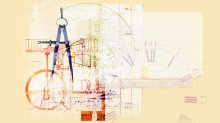
7 Smart, Fast Ways to Do Formative Assessment
Within these methods you’ll find close to 40 tools and tricks for finding out what your students know while they’re still learning.
Formative assessment—discovering what students know while they’re still in the process of learning it—can be tricky. Designing just the right assessment can feel high stakes—for teachers, not students—because we’re using it to figure out what comes next. Are we ready to move on? Do our students need a different path into the concepts? Or, more likely, which students are ready to move on and which need a different path?
When it comes to figuring out what our students really know, we have to look at more than one kind of information. A single data point—no matter how well designed the quiz, presentation, or problem behind it—isn’t enough information to help us plan the next step in our instruction.
Add to that the fact that different learning tasks are best measured in different ways, and we can see why we need a variety of formative assessment tools we can deploy quickly, seamlessly, and in a low-stakes way—all while not creating an unmanageable workload. That’s why it’s important to keep it simple: Formative assessments generally just need to be checked, not graded, as the point is to get a basic read on the progress of individuals, or the class as a whole.
7 Approaches to Formative Assessment
1. Entry and exit slips: Those marginal minutes at the beginning and end of class can provide some great opportunities to find out what kids remember. Start the class off with a quick question about the previous day’s work while students are getting settled—you can ask differentiated questions written out on chart paper or projected on the board, for example.
Exit slips can take lots of forms beyond the old-school pencil and scrap paper. Whether you’re assessing at the bottom of Bloom’s taxonomy or the top, you can use tools like Padlet or Poll Everywhere , or measure progress toward attainment or retention of essential content or standards with tools like Google Classroom’s Question tool , Google Forms with Flubaroo , and Edulastic , all of which make seeing what students know a snap.
A quick way to see the big picture if you use paper exit tickets is to sort the papers into three piles : Students got the point; they sort of got it; and they didn’t get it. The size of the stacks is your clue about what to do next.
No matter the tool, the key to keeping students engaged in the process of just-walked-in or almost-out-the-door formative assessment is the questions. Ask students to write for one minute on the most meaningful thing they learned. You can try prompts like:
- What are three things you learned, two things you’re still curious about, and one thing you don’t understand?
- How would you have done things differently today, if you had the choice?
- What I found interesting about this work was...
- Right now I’m feeling...
- Today was hard because...
Or skip the words completely and have students draw or circle emojis to represent their assessment of their understanding.
2. Low-stakes quizzes and polls: If you want to find out whether your students really know as much as you think they know, polls and quizzes created with Socrative or Quizlet or in-class games and tools like Quizalize , Kahoot , FlipQuiz, Gimkit , Plickers , and Flippity can help you get a better sense of how much they really understand. (Grading quizzes but assigning low point values is a great way to make sure students really try: The quizzes matter, but an individual low score can’t kill a student’s grade.) Kids in many classes are always logged in to these tools, so formative assessments can be done very quickly. Teachers can see each kid’s response, and determine both individually and in aggregate how students are doing.
Because you can design the questions yourself, you determine the level of complexity. Ask questions at the bottom of Bloom’s taxonomy and you’ll get insight into what facts, vocabulary terms, or processes kids remember. Ask more complicated questions (“What advice do you think Katniss Everdeen would offer Scout Finch if the two of them were talking at the end of chapter 3?”), and you’ll get more sophisticated insights.
3. Dipsticks: So-called alternative formative assessments are meant to be as easy and quick as checking the oil in your car, so they’re sometimes referred to as dipsticks . These can be things like asking students to:
- write a letter explaining a key idea to a friend,
- draw a sketch to visually represent new knowledge, or
- do a think, pair, share exercise with a partner.
Your own observations of students at work in class can provide valuable data as well, but they can be tricky to keep track of. Taking quick notes on a tablet or smartphone, or using a copy of your roster, is one approach. A focused observation form is more formal and can help you narrow your note-taking focus as you watch students work.
4. Interview assessments: If you want to dig a little deeper into students’ understanding of content, try discussion-based assessment methods. Casual chats with students in the classroom can help them feel at ease even as you get a sense of what they know, and you may find that five-minute interview assessments work really well. Five minutes per student would take quite a bit of time, but you don’t have to talk to every student about every project or lesson.
You can also shift some of this work to students using a peer-feedback process called TAG feedback (Tell your peer something they did well, Ask a thoughtful question, Give a positive suggestion). When you have students share the feedback they have for a peer, you gain insight into both students’ learning.
For more introverted students—or for more private assessments—use Flipgrid , Explain Everything , or Seesaw to have students record their answers to prompts and demonstrate what they can do.
5. Methods that incorporate art: Consider using visual art or photography or videography as an assessment tool. Whether students draw, create a collage, or sculpt, you may find that the assessment helps them synthesize their learning . Or think beyond the visual and have kids act out their understanding of the content. They can create a dance to model cell mitosis or act out stories like Ernest Hemingway’s “Hills Like White Elephants” to explore the subtext.
6. Misconceptions and errors: Sometimes it’s helpful to see if students understand why something is incorrect or why a concept is hard. Ask students to explain the “ muddiest point ” in the lesson—the place where things got confusing or particularly difficult or where they still lack clarity. Or do a misconception check : Present students with a common misunderstanding and ask them to apply previous knowledge to correct the mistake, or ask them to decide if a statement contains any mistakes at all, and then discuss their answers.
7. Self-assessment: Don’t forget to consult the experts—the kids. Often you can give your rubric to your students and have them spot their strengths and weaknesses.
You can use sticky notes to get a quick insight into what areas your kids think they need to work on. Ask them to pick their own trouble spot from three or four areas where you think the class as a whole needs work, and write those areas in separate columns on a whiteboard. Have you students answer on a sticky note and then put the note in the correct column—you can see the results at a glance.
Several self-assessments let the teacher see what every kid thinks very quickly. For example, you can use colored stacking cups that allow kids to flag that they’re all set (green cup), working through some confusion (yellow), or really confused and in need of help (red).
Similar strategies involve using participation cards for discussions (each student has three cards—“I agree,” “I disagree,” and “I don’t know how to respond”) and thumbs-up responses (instead of raising a hand, students hold a fist at their belly and put their thumb up when they’re ready to contribute). Students can instead use six hand gestures to silently signal that they agree, disagree, have something to add, and more. All of these strategies give teachers an unobtrusive way to see what students are thinking.
No matter which tools you select, make time to do your own reflection to ensure that you’re only assessing the content and not getting lost in the assessment fog . If a tool is too complicated, is not reliable or accessible, or takes up a disproportionate amount of time, it’s OK to put it aside and try something different.
AMK RESOURCE WORLD
One Site for all Free Study Resources
Home » Nali Kali (Class 1 to 3) Formative Assessment (FA) 1 Model Assessment Papers
Nali Kali (Class 1 to 3) Formative Assessment (FA) 1 Model Assessment Papers

Karnataka State Nali Kali (Class 1 to 3) Formative Assessment (FA) 1 Model Assessment Papers of all Subjects (First Language Kannada, Second Language English, Mathematics, Health and Environment / Environmental Studies) prepared by Subject Experts been provided for reference to teachers teaching Nali Kali (Class 1 to 3)
The teachers teaching First Language Kannada, Second Language English, Mathematics, Health and Environment / Environmental Studies for the students of Nali Kali (Class 1 to 3) can utilise these Formative Assessment (FA) 1 Model Assessment Papers to assess the continuous and comprehensive learning among the students,
Nali Kali (Class 1 to 3) Formative Assessment (FA) 1 Learning indications (Learning Indicators, Instructions for Assessment, Assigned Marks) and Teachers individual marks list format of First Language Kannada, Second Language English, Mathematics, Health and Environment / Environmental Studies been provided to asses the students learning and fill the learning gap
FA 1 LEARNING INDICATIONS
Nali Kali (Class 1 to 3) Formative Assessment (FA) 1 1 Learning indications of First Language Kannada, Second Language English, Mathematics, Health and Environment / Environmental Studies
FA 1 MODEL PAPERS
Nali Kali (Class 1 to 3) Formative Assessment (FA) 1 Model Papers of First Language Kannada, Second Language English, Mathematics, Health and Environment / Environmental Studies, Prepared by NALI KALI Resource Team, Yadgiri
FA 1 FORMATS
Nali Kali (Class 1 to 3) Formative Assessment (FA) 1 Teachers individual and Consolidated formats for Marks Entry
Related Articles

Newest Job Openings View All

Jharkhand High Court Recruitment 2024: Apply for 410 Assistant / Clerk posts

BCECEB Recruitment 2024: Apply for 825 Senior Resident / Tutor posts

AIASL Recruitment 2024: Apply for 422 Utility Agent Cum Ramp Driver & Handyman / Handywoman Posts

RPF / RPSF Recruitment 2024: Apply for 4,660 Constable and Sub Inspector Posts

South East Central Railway Recruitment 2024: Apply for 861 Act Apprentice Posts
Fresh scholarship listings view all.

Sitaram Jindal Scholarship 2024 Applications Now Open

IET India Scholarship Award 2024 Applications Now Open

Ujjivan Small Finance Bank Transgender Scholarship 2024-25 Applications Now Open

Kotak Suraksha Scholarship Program 2024-25 Applications open Now

Fortis and Agilus Healthcare Scholarship 2024 announced, APPLY NOW
Sslc study materials view all.

SSLC Exams : 1st Lang Kannada complete Study Materials

SSLC Exams Maths Complete Study Materials

SSLC Exams 2nd Lang English Complete Study Materials

SSLC Exams Science Complete Study Materials
Top recommended, admissions view all.

Azim Premji University invite applications for Postgraduate Diploma in Development Leadership 2024

KILT 3 years Diploma in Leather and Fashion Technology Admissions 2024 Applications Now Open

NCET 2024: Application open for 4 Year Integrated Teacher Education Programme (ITEP)
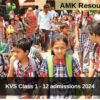
Kendriya Vidyalaya Class 1 admissions 2024 Registrations Now Open

Indian Institute of Astrophysics (IIA) Ph.D admissions 2024 registrations started
Trending topics view all.
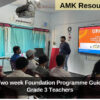
UPAAN: Two week Foundation Programme Guidelines for Grade 3 Teachers released

CBSE Releases Class 9 to 12 Curriculum for the 2024 – 25 Academic Session

TCS NQT 2024 Open for Graduates, Apply Now for Exciting IT Careers

Central Government announce 4% DA Hike for Employees, Effective January 1st, 2024

ISRO Young Scientist Programme (YUVIKA) 2024 notification released
Daily trends.
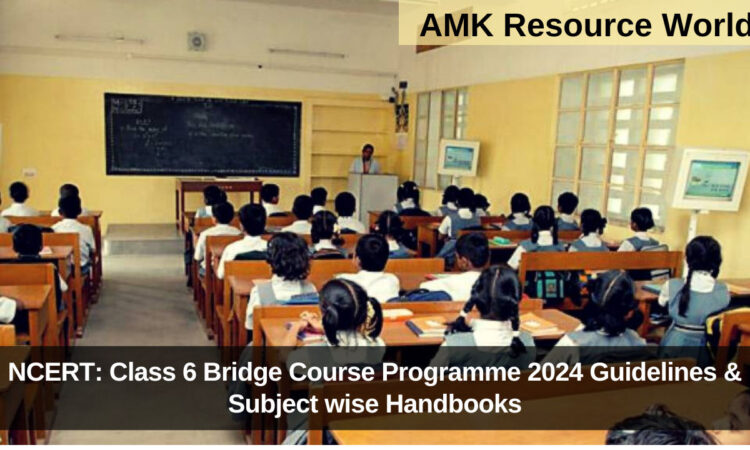
NCERT: Class 6 Bridge Course Programme 2024 Guidelines & Subject wise Handbooks released
Newest content.

JAC Class 10th or Matric exam 2024 results date & time announced

KCET 2024: Biology & Maths unofficial Key answers released, Check your Score

Muskaan Scholarship Program 2023-24 Applications Now Open
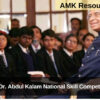
AICTSD: Dr Abdul Kalam National Skill Competition 2024 Applications Open
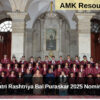
Pradhan Mantri Rashtriya Bal Puraskar 2025 Nominations Now Open

Karnataka D.P.Ed 1st & 2nd year Exam 2024 notification & time table released

SWAYAM January 2024 Applications date extended
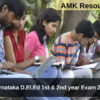
Karnataka D.El.Ed 1st & 2nd year Exam 2024 time table & notification released

KPCL: Asst Engineer, Jr Engineer & Other posts Recruitment Exam final key answers released

NTA GAT-B, BET 2024 admit card released
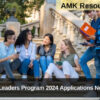
Aspire Leaders Program 2024 Applications Now Open

ISRO Online Course for School students on Space Science, Technology and Applications registrations started

Pradhan Mantri Rashtriya Bal Puraskar 2024 announced, Complete List of Winners
Must read view all.

Recent Posts
Copyright © 2024 AMK RESOURCE WORLD
Design by ThemesDNA.com
Eberly Center
Teaching excellence & educational innovation, what is the difference between formative and summative assessment, formative assessment.
The goal of formative assessment is to monitor student learning to provide ongoing feedback that can be used by instructors to improve their teaching and by students to improve their learning. More specifically, formative assessments:
- help students identify their strengths and weaknesses and target areas that need work
- help faculty recognize where students are struggling and address problems immediately
Formative assessments are generally low stakes , which means that they have low or no point value. Examples of formative assessments include asking students to:
- draw a concept map in class to represent their understanding of a topic
- submit one or two sentences identifying the main point of a lecture
- turn in a research proposal for early feedback
Summative assessment
The goal of summative assessment is to evaluate student learning at the end of an instructional unit by comparing it against some standard or benchmark.
Summative assessments are often high stakes , which means that they have a high point value. Examples of summative assessments include:
- a midterm exam
- a final project
- a senior recital
Information from summative assessments can be used formatively when students or faculty use it to guide their efforts and activities in subsequent courses.
CONTACT US to talk with an Eberly colleague in person!
- Faculty Support
- Graduate Student Support
- Canvas @ Carnegie Mellon
- Quick Links

- eLearning Platform
- eLearning Content
- Access 800 Courses on our Platform
- Bespoke eLearning
- Virtual Training
- Our Pricing
- Request a Demo
- Content Partnerships
- Whitepapers
- Most Popular Blogs
- Personal Learning Journeys
- Training Feedback Form
- Training Needs Analysis Template
- Personal Development Plan Template
- Learning and Development Strategy
- Talent Management Strategy
- Kirkpatrick Evaluation Model
- Microlearning
- Informal Learning
- 70 20 10 Learning
Home » Blog » Formative and Summative Assessments: Examples and Differences
Formative and Summative Assessments: Examples and Differences
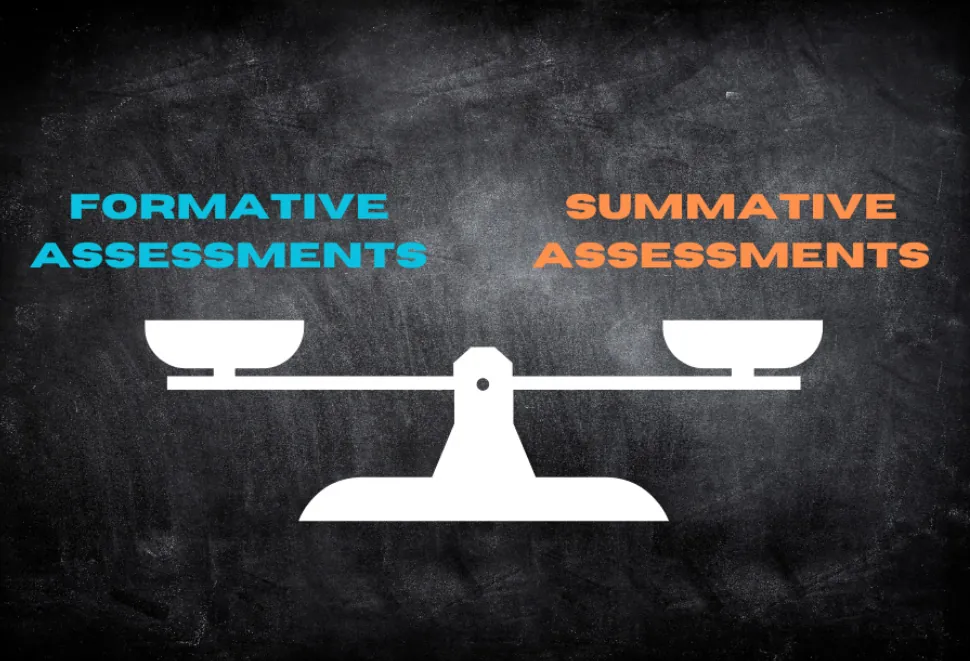
One of the primary benefits of using formative and summative assessments is that you aren’t forced to choose between them. They work exceptionally well when used in combination.
In this article, we’ll be breaking down precisely what formative and summative assessments are, the key differences between them, the benefits of their use, and providing a range of examples to help illustrate how they can be implemented in the classroom.
If you’re looking for an effective way to assess student learning and measure progress, read on to find out how formative and summative assessments can help.

Learn How To Create Personal Learning Journeys For FREE!
Formative assessments: definition and purpose.
Before we get into examples of their use, it’s essential that we first define precisely what both formative and summative assessments are and how they differ.
Formative assessments are employed regularly throughout a set learning period, be that a chapter, unit, or term, and help track progress and identify areas where students may struggle or need more support.
They also give the teacher and course designer the data they need to improve the learning experience and make any necessary changes that may be required throughout a system.
Rather than strict exams, formative assessments are usually relatively low-stakes, meaning they do not always need to be graded or even marked. This helps to create a non-threatening atmosphere and encourages students to take risks in their learning without fear of failure.
Formative assessment tasks usually rely on feedback from both students and the teacher, with learners receiving feedback on performance as soon as possible.
Uses of Formative Assessments
As mentioned, one of the primary uses of a formative assessment is to gauge student understanding and identify knowledge gaps that may need extra work.
Formative assessments can also be used to help inform curricular decisions, provide valuable data on the effectiveness of a course or lesson, and allow students to monitor their progress over time.
In addition, formative assessments are valuable in helping teachers gain real-time insight into a group’s collective understanding, allowing them to rapidly adapt their training or lessons accordingly.
Benefits of Using Formative Assessments
There are a range of benefits to employing formative assessments as part of your teaching strategy, including the following:
- Improved student or employee engagement and motivation – By allowing students to track their learning journey, you can help them take ownership of their learning experience. This can be highly motivating for students, as it encourages a sense of progress and accomplishment.
- Better assessment of real-world understanding – By using formative assessments that involve practical skills or application, you can better understand how well your students understand the real-world implications of the content they are studying.
- Enables rapid identification of areas of difficulty for learners – Through formative assessments, you can quickly identify areas that students may be struggling with. This helps to ensure that these areas are addressed rapidly and effectively.
- Allows teachers to tailor their lessons to the needs of the group – Teachers and course designers can use the data from formative assessments to tailor their studies according to the group’s needs and ensure that they meet all learning objectives.
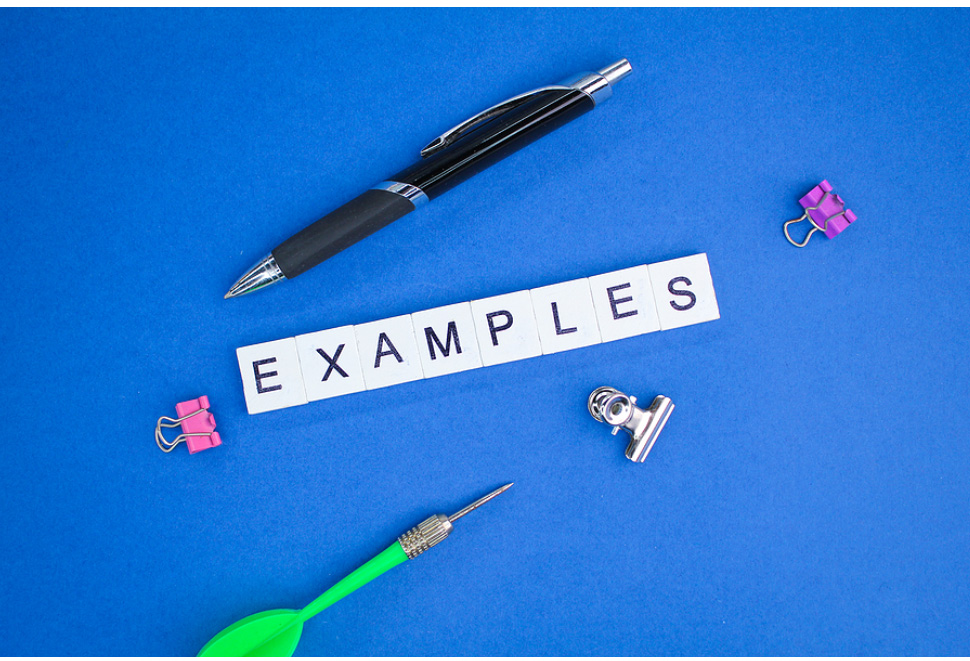
Examples of Formative Assessments
To clarify how formative assessments can be used, below are a few examples of tasks that could be used both in the classroom and in a digital learning environment.
Classroom-Based Examples
The following examples can be valuable to employ in a classroom setting:
1. Quizzes and polls
Simple and easy to execute, quizzes and polls are a low-effort way of gauging student understanding at regular intervals throughout a lesson.
2. Peer feedback and self-assessment
Peer-based feedback sessions and self-assessment questionnaires can help identify areas where students may need extra support or guidance while giving vital insight into how students perceive their progress.
3. Class discussions and debates
Encouraging students to discuss their different perspectives on a given topic or concept allows teachers to better understand how well they comprehend the material. It also gives students the opportunity to have their ideas heard and helps create a sense of solidarity within the classroom.
Online and Digital Examples
With the rise in the use of digital learning tools and technologies , there is also a range of online-based practices that can be used as formative assessments, including:
1. Interactive quizzes and games
The gamification of quizzes or other learning activities can provide an engaging way to assess student understanding and offer real-time feedback.
2. Virtual simulations and case studies
Where more vocational skills are being taught, virtual simulations and case studies can test students’ problem-solving capabilities in a low-stakes environment.
3. Online discussion forums and feedback platforms
One of the benefits of using an online learning platform is the wide range of features available to assess student understanding. Discussion forums, peer feedback platforms, and automated feedback systems can all be used as formative assessment tools.

Summative Assessments: Definition and Purpose
Compared to formative assessments, summative assessments are conducted at the end of a defined learning period and often represent the final grade for the course.
To provide a comprehensive assessment grade, summative assessments evaluate a student’s overall understanding and performance of the skill or concept studied.
They can also be used to track educational progress over time, such as in standardised testing, as well as help to inform curricular decisions and the effectiveness of teaching methods.
Uses of Summative Assessments
Summative assessments test student mastery of content, assess their overall understanding of a subject or topic area and generally give them a final mark.
For teachers and course designers, a summative assessment allows them to measure the effectiveness of their teaching and make any necessary changes or improvements.
Summative assessments can also be used to compare student performance across different classes, courses, and programs.
Benefits of Summative Assessments
As with formative assessments, there is a range of benefits associated with the use of summative assessments, including:
- Provides an overall assessment score – Summative assessments can provide a more accurate assessment of student understanding and performance, offering an overall grade or score.
- Helps track educational progress over time – Educators can track student progress to identify improvement areas through standardised testing or other summative assessments.
- Helps inform curricular decisions – Summative assessments can assess the effectiveness of a particular course or program and help inform future curricular choices.
- Offers an efficient way to measure learning outcomes – By providing an overall assessment grade, summative assessments offer a convenient way to measure the success of a teaching strategy in one go.

Examples of Summative Assessments
To clarify how summative assessments can be implemented, here are a few examples of traditional assessment methods, such as essays and exams, and performance-based assessments, such as presentations and projects.
Traditional Assessment Methods
Below are some examples of traditional assessment methods:
1. Examinations and final tests
Examinations are widely used to assess student knowledge and understanding at the end of a course or program. They are easy to implement and provide a quick and efficient way to evaluate student performance.
2. Term papers and essays
Essays and term papers are another traditional assessment method used alongside examinations. Essays test students’ ability to analyse a given topic or concept in detail, providing insight into their understanding of the subject matter.
3. Projects and presentations
Where skill-based or vocational courses are being taught, projects and presentations can test a student’s performance in class. These assessments allow students to demonstrate their understanding of the subject matter and show their ability to apply and transfer the knowledge in a practical context.
Performance-Based Assessments
Performance-based assessments are best employed when assessing practical skills or processes. Examples of performance-based summative assessments include:
1. Practical exams and demonstrations
Practical tests and demonstrations are often used to assess students’ physical abilities, such as in sports or vocational courses. These assessments test a student’s understanding of a particular skill or concept by having them demonstrate it in a real-world setting.
2. Portfolios and showcases
Where creative or design-based courses are being taught, portfolios and showcases allow students to demonstrate their understanding of the concepts in a practical way. These assessments require students to use their creative skills to produce a tangible output, such as an artwork or multimedia presentation.
3. Capstone projects and dissertations
Dissertations and capstone projects are often used to assess students’ understanding of complex topics or skills. These assessments require students to demonstrate their knowledge of the subject matter by producing an in-depth research or project that meets specific criteria.

Critical Differences Between Formative and Summative Assessments
Now that you have a fuller understanding of what both formative and summative assessments represent and how they can be employed, here’s a summary outlining the key differences between the two:
Timing and Frequency
One of the most essential distinctions between the two types of assessment is when they are conducted. Formative assessments occur throughout the course and act as checkpoints to monitor student progress.
In contrast, summative assessments are shown at the end of a defined learning period and only count towards an overall grade or score.
Purpose and Focus
Formative assessments are designed to provide feedback on understanding and inform instruction in real-time. In contrast, summative assessments evaluate student performance of a skill or concept and can help inform curriculum decisions.
Feedback and Evaluation Process
The feedback and evaluation process for formative and summative assessments differs significantly. Formative assessments are designed to offer real-time feedback on performance.
In contrast, summative assessments provide an overall assessment score or grade that reflects the student’s understanding of the subject matter at the end of a course or program.

Which is the Right Assessment Approach to Utilise?
Choosing the correct assessment approach for your students ultimately depends on the goals you are trying to achieve, the type of course or program being taught and the knowledge and skills that need to be assessed.
To help you decide, consider the following:
Considerations for Selecting Formative Assessments
Some of the critical considerations for making use of formative assessments include:
- Regular feedback – Formative assessments should be implemented regularly to ensure students receive regular feedback on their understanding and performance.
- Low-stakes testing – As formative tests don’t count towards an overall grade, they should be designed as low-stakes tests to help encourage participation.
- Inform instruction – Formative assessment results can inform instruction in real-time, allowing educators to tailor their teaching approach to student needs.
Considerations for Selecting Summative Assessments
When making use of summative assessments, it’s essential to consider the following points:
- Assessment goals – Before designing a summative assessment, clearly define the purposes of the evaluation and how it will be used to evaluate student performance.
- Assessment criteria – When creating a summative assessment, ensure that you set clear and concise evaluation criteria that allow students to demonstrate their understanding fully.
- Inter-rater reliability – To ensure fairness and accuracy, consider having multiple assessors score each student’s work when creating a summative assessment.
Using Both Formative and Summative Assessments in Learning and Development
As mentioned, one of the primary benefits of using formative and summative assessments in learning and development is that they can provide a more comprehensive evaluation of student performance.
By implementing both assessment forms, educators can better understand their student’s progress and tailor their instruction for maximum impact.
Formative assessments can measure progress and inform instruction in real-time, while summative assessments provide an overall score or grade that indicates learning success.
Final Thoughts
While formative and summative assessments have apparent differences, such as in their purpose, timing and feedback mechanisms, there are significant benefits to using both assessment types in learning and development.
Educators can better assess student performance and tailor instruction by implementing formative and summative assessments. Additionally, the use of both reviews provides a comprehensive view of understanding that can be used to inform curriculum decisions.
If you are looking for more guidance and resources on creating and implementing formative and summative assessments, check out the other articles on the Skillshub blog .
As an eLearning company , we are committed to creating efficient and impactful learning experiences. Our team are experts in developing eLearning content , so skillshub can help create customised learning materials tailored to your organisation’s needs. To learn more about our services, get in touch with us today.

Sean McPheat
Sean is the CEO of Skillshub. He’s a published author and has been featured on CNN, BBC and ITV as a leading authority in the learning and development industry. Sean is responsible for the vision and strategy at Skillshub, helping to ensure innovation within the company.
Updated on: 20 September, 2023
Would your connections like this too? Please share.

You might also be interested in…

Pedagogy vs Andragogy: What’s the Difference for Learning Strategies?

The Ultimate Guide To Neurodiversity in the Workplace

What is Ebbinghaus’s Forgetting Curve and How to Overcome it

What Is a Learner-Centred Approach and Why Is It Important

Importance and Benefits of Providing Employee Training

10 Important Steps for Building Relationships at Work
- elearning Content
- Get In Touch
14 Examples of Formative Assessment [+FAQs]

Traditional student assessment typically comes in the form of a test, pop quiz, or more thorough final exam. But as many teachers will tell you, these rarely tell the whole story or accurately determine just how well a student has learned a concept or lesson.
That’s why many teachers are utilizing formative assessments. While formative assessment is not necessarily a new tool, it is becoming increasingly popular amongst K-12 educators across all subject levels.
Curious? Read on to learn more about types of formative assessment and where you can access additional resources to help you incorporate this new evaluation style into your classroom.
What is Formative Assessment?
Online education glossary EdGlossary defines formative assessment as “a wide variety of methods that teachers use to conduct in-process evaluations of student comprehension, learning needs, and academic progress during a lesson, unit, or course.” They continue, “formative assessments help teachers identify concepts that students are struggling to understand, skills they are having difficulty acquiring, or learning standards they have not yet achieved so that adjustments can be made to lessons, instructional techniques, and academic support.”
The primary reason educators utilize formative assessment, and its primary goal, is to measure a student’s understanding while instruction is happening. Formative assessments allow teachers to collect lots of information about a student’s comprehension while they’re learning, which in turn allows them to make adjustments and improvements in the moment. And, the results speak for themselves — formative assessment has been proven to be highly effective in raising the level of student attainment, increasing equity of student outcomes, and improving students’ ability to learn, according to a study from the Organization for Economic Co-operation and Development (OECD).
On the flipside of the assessment coin is summative assessments, which are what we typically use to evaluate student learning. Summative assessments are used after a specific instructional period, such as at the end of a unit, course, semester, or even school year. As learning and formative assessment expert Paul Black puts it, “when the cook tastes the soup, that’s formative assessment. When a customer tastes the soup, that’s summative assessment.”
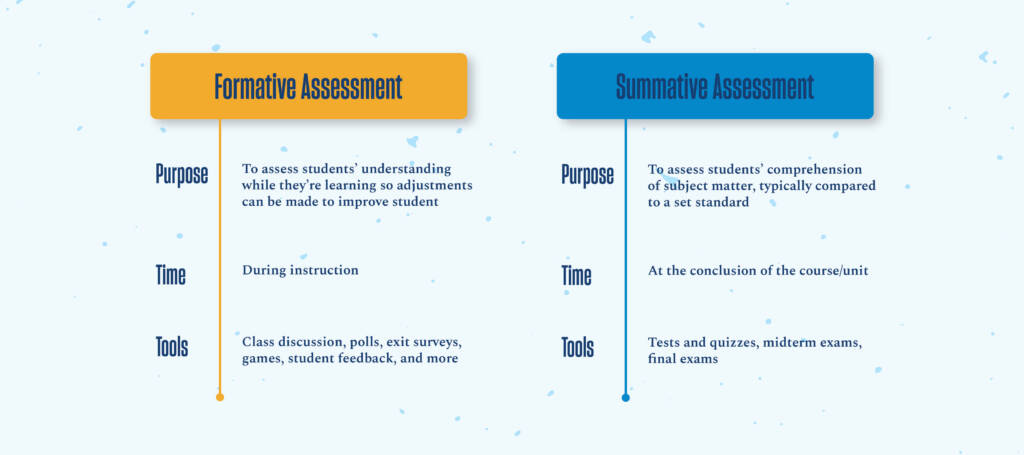
14 Examples of Formative Assessment Tools & Strategies
There are many types of formative assessment tools and strategies available to teachers, and it’s even possible to come up with your own. However, here are some of the most popular and useful formative assessments being used today.
- Round Robin Charts
Students break out into small groups and are given a blank chart and writing utensils. In these groups, everyone answers an open-ended question about the current lesson. Beyond the question, students can also add any relevant knowledge they have about the topic to their chart. These charts then rotate from group to group, with each group adding their input. Once everyone has written on every chart, the class regroups and discusses the responses.
- Strategic Questioning
This formative assessment style is quite flexible and can be used in many different settings. You can ask individuals, groups, or the whole class high-level, open-ended questions that start with “why” or “how.” These questions have a two-fold purpose — to gauge how well students are grasping the lesson at hand and to spark a discussion about the topic.
- Three-Way Summaries
These written summaries of a lesson or subject ask students to complete three separate write-ups of varying lengths: short (10-15 words), medium (30-50 words), and long (75-100). These different lengths test students’ ability to condense everything they’ve learned into a concise statement, or elaborate with more detail. This will demonstrate to you, the teacher, just how much they have learned, and it will also identify any learning gaps.
- Think-Pair-Share
Think-pair-share asks students to write down their answers to a question posed by the teacher. When they’re done, they break off into pairs and share their answers and discuss. You can then move around the room, dropping in on discussions and getting an idea of how well students are understanding.
- 3-2-1 Countdown
This formative assessment tool can be written or oral and asks students to respond to three very simple prompts: Name three things you didn’t know before, name two things that surprised you about this topic, and name one you want to start doing with what you’ve learned. The exact questions are flexible and can be tailored to whatever unit or lesson you are teaching.
- Classroom Polls
This is a great participation tool to use mid-lesson. At any point, pose a poll question to students and ask them to respond by raising their hand. If you have the capability, you can also use online polling platforms and let students submit their answers on their Chromebooks, tablets, or other devices.
- Exit/Admission Tickets
Exit and admission tickets are quick written exercises that assess a student’s comprehension of a single day’s lesson. As the name suggests, exit tickets are short written summaries of what students learned in class that day, while admission tickets can be performed as short homework assignments that are handed in as students arrive to class.
- One-Minute Papers
This quick, formative assessment tool is most useful at the end of the day to get a complete picture of the classes’ learning that day. Put one minute on the clock and pose a question to students about the primary subject for the day. Typical questions might be:
- What was the main point?
- What questions do you still have?
- What was the most surprising thing you learned?
- What was the most confusing aspect and why?
- Creative Extension Projects
These types of assessments are likely already part of your evaluation strategy and include projects like posters and collage, skit performances, dioramas, keynote presentations, and more. Formative assessments like these allow students to use more creative parts of their skillset to demonstrate their understanding and comprehension and can be an opportunity for individual or group work.
Dipsticks — named after the quick and easy tool we use to check our car’s oil levels — refer to a number of fast, formative assessment tools. These are most effective immediately after giving students feedback and allowing them to practice said skills. Many of the assessments on this list fall into the dipstick categories, but additional options include writing a letter explaining the concepts covered or drawing a sketch to visually represent the topic.
- Quiz-Like Games and Polls
A majority of students enjoy games of some kind, and incorporating games that test a student’s recall and subject aptitude are a great way to make formative assessment more fun. These could be Jeopardy-like games that you can tailor around a specific topic, or even an online platform that leverages your own lessons. But no matter what game you choose, these are often a big hit with students.
- Interview-Based Assessments
Interview-based assessments are a great way to get first-hand insight into student comprehension of a subject. You can break out into one-on-one sessions with students, or allow them to conduct interviews in small groups. These should be quick, casual conversations that go over the biggest takeaways from your lesson. If you want to provide structure to student conversations, let them try the TAG feedback method — tell your peer something they did well, ask a thoughtful question, and give a positive suggestion.
- Self Assessment
Allow students to take the rubric you use to perform a self assessment of their knowledge or understanding of a topic. Not only will it allow them to reflect on their own work, but it will also very clearly demonstrate the gaps they need filled in. Self assessments should also allow students to highlight where they feel their strengths are so the feedback isn’t entirely negative.
- Participation Cards
Participation cards are a great tool you can use on-the-fly in the middle of a lesson to get a quick read on the entire classes’ level of understanding. Give each student three participation cards — “I agree,” “I disagree,” and “I don’t know how to respond” — and pose questions that they can then respond to with those cards. This will give you a quick gauge of what concepts need more coverage.
5 REASONS WHY CONTINUING EDUCATION MATTERS FOR EDUCATORS
The education industry is always changing and evolving, perhaps now more than ever. Learn how you can be prepared by downloading our eBook.

List of Formative Assessment Resources
There are many, many online formative assessment resources available to teachers. Here are just a few of the most widely-used and highly recommended formative assessment sites available.
- Arizona State Dept of Education
FAQs About Formative Assessment
The following frequently asked questions were sourced from the Association for Supervision and Curriculum Development (ASCD), a leading education professional organization of more than 100,000 superintendents, principals, teachers, and advocates.
Is formative assessment something new?
No and yes. The concept of measuring a student’s comprehension during lessons has existed for centuries. However, the concept of formative assessment as we understand it didn’t appear until approximately 40 years ago, and has progressively expanded into what it is today.
What makes something a formative assessment?
ASCD characterized formative assessment as “a way for teachers and students to gather evidence of learning, engage students in assessment, and use data to improve teaching and learning.” Their definition continues, “when you use an assessment instrument— a test, a quiz, an essay, or any other kind of classroom activity—analytically and diagnostically to measure the process of learning and then, in turn, to inform yourself or your students of progress and guide further learning, you are engaging in formative assessment. If you were to use the same instrument for the sole purpose of gathering data to report to a district or state or to determine a final grade, you would be engaging in summative assessment.”
Does formative assessment work in all content areas?
Absolutely, and it works across all grade levels. Nearly any content area — language arts, math, science, humanities, and even the arts or physical education — can utilize formative assessment in a positive way.
How can formative assessment support the curriculum?
Formative assessment supports curricula by providing real-time feedback on students’ knowledge levels and comprehension of the subject at hand. When teachers regularly utilize formative assessment tools, they can find gaps in student learning and customize lessons to fill those gaps. After term is over, teachers can use this feedback to reshape their curricula.
How can formative assessment be used to establish instructional priorities?
Because formative assessment supports curriculum development and updates, it thereby influences instructional priorities. Through student feedback and formative assessment, teachers are able to gather data about which instructional methods are most (and least) successful. This “data-driven” instruction should yield more positive learning outcomes for students.
Can formative assessment close achievement gaps?
Formative assessment is ideal because it identifies gaps in student knowledge while they’re learning. This allows teachers to make adjustments to close these gaps and help students more successfully master a new skill or topic.
How can I help my students understand formative assessment?
Formative assessment should be framed as a supportive learning tool; it’s a very different tactic than summative assessment strategies. To help students understand this new evaluation style, make sure you utilize it from the first day in the classroom. Introduce a small number of strategies and use them repeatedly so students become familiar with them. Eventually, these formative assessments will become second nature to teachers and students.
Before you tackle formative assessment, or any new teaching strategy for that matter, consider taking a continuing education course. At the University of San Diego School of Professional and Continuing Education, we offer over 500 courses for educators that can be completed entirely online, and many at your own pace. So no matter what your interests are, you can surely find a course — or even a certificate — that suits your needs.
Be Sure To Share This Article
- Share on Twitter
- Share on Facebook
- Share on LinkedIn
Your Salary
Browse over 500+ educator courses and numerous certificates to enhance your curriculum and earn credit toward salary advancement.
Related Posts


English Kannada Dictionary | ಇಂಗ್ಲೀಶ್ ಕನ್ನಡ ನಿಘಂಟು
The keyboard uses the ISCII layout developed by the Government of India. It is also used in Windows, Apple and other systems. There is a base layout, and an alternative layout when the Shift key is pressed. If you have any questions about it, please contact us.
- Pronunciation
- Word Network
- Conjugation
- Inflections
Description
- More matches
- Word Finder
formative - Meaning in Kannada
Adjective .
- ರೂಪಿಸಲು ಸಹಾಯಕವಾಗುವ
formative Word Forms & Inflections
Definitions and meaning of formative in english, formative adjective.
- plastic , shaping
- "a formative experience"
- "a formative influence"
- "the plastic forces of nature"
- "a formative zone in developing bone"
formative noun
Synonyms of formative, more matches for formative.
What is another word for formative ?
Sentences with the word formative
Words that rhyme with formative
English Kannada Translator
Words starting with
What is formative meaning in kannada.
Other languages: formative meaning in Hindi
Tags for the entry "formative"
What is formative meaning in Kannada, formative translation in Kannada, formative definition, pronunciations and examples of formative in Kannada.
SHABDKOSH Apps
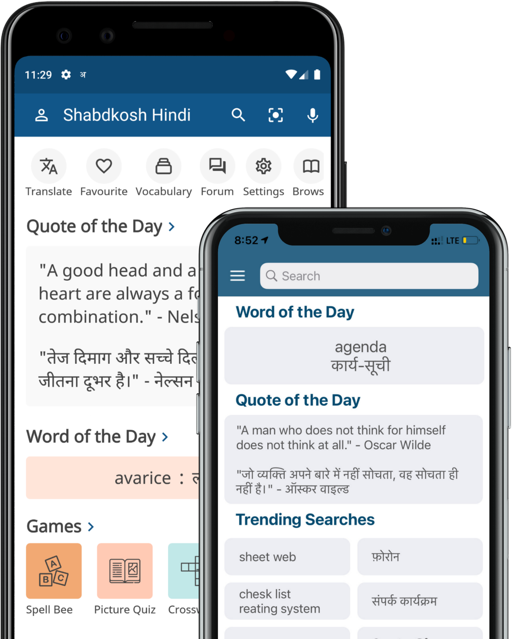
Ad-free experience & much more

Basic rules of grammar

Tips to practice grammar effectively
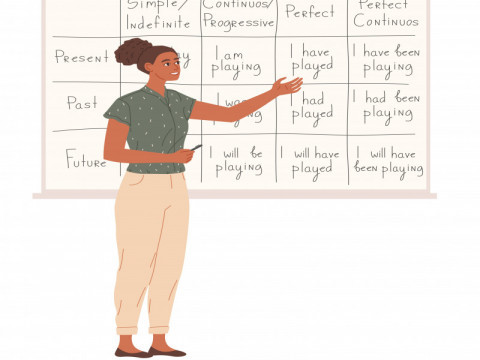
English tenses
Our Apps are nice too!
Dictionary. Translation. Vocabulary. Games. Quotes. Forums. Lists. And more...


Vocabulary & Quizzes
Try our vocabulary lists and quizzes.
Vocabulary Lists
We provide a facility to save words in lists.
Basic Word Lists
Custom word lists.
You can create your own lists to words based on topics.
Login/Register
To manage lists, a member account is necessary.
Share with friends
Social sign-in.
Translation

If you want to access full services of shabdkosh.com
Please help Us by disabling your ad blockers.
or try our SHABDKOSH Premium for ads free experience.
Steps to disable Ads Blockers.
- Click on ad blocker extension icon from browser's toolbar.
- Choose the option that disables or pauses Ad blocker on this page.
- Refresh the page.
Spelling Bee
Hear the words in multiple accents and then enter the spelling. The games gets challenging as you succeed and gets easier if you find the words not so easy.
The game will show the clue or a hint to describe the word which you have to guess. It’s our way of making the classic hangman game!
Antonym Match
Choose the right opposite word from a choice of four possible words. We have thousand of antonym words to play!
Language Resources
Get our apps, keep in touch.
- © 2024 SHABDKOSH.COM, All Rights Reserved.
- Terms of Use
- Privacy Policy
Liked Words
Shabdkosh Premium
Try SHABDKOSH Premium and get
- Ad free experience.
- No limit on translation.
- Bilingual synonyms translations.
- Access to all Vocabulary Lists and Quizzes.
- Copy meanings.
Already a Premium user?
Karnataka Model Paper 2024 Class 1
KSEEB Model Paper 2024 Class 1 Pdf Download with Answers for Kannada Medium, English Medium, Hindi Medium, Urdu Medium & Students for Small Answers, Long Answer, Very Long Answer Questions, and Essay Type Questions to Term1 & Term2 Exams at https://sslc.karnataka.gov.in/, http://kseeb.kar.nic.in/, https://www.schooleducation.kar.nic.in/index.html…
- Name of the Question Paper : Kar Model Paper 2024 for Class 1.
- Supported Education Boards : Karnataka Secondary Education Examination Board.
- Location : All Regions of the Karnataka (Karnataka & Regions of the State).
- Name of the Subjects : Environmental Education (EVS), Mathematics, General knowledge (GK), Computers, Science, Social Studies and etc.
- Name of the Language Subjects : Kannada, English, Hindi, Urdu, Sanskrit and etc.
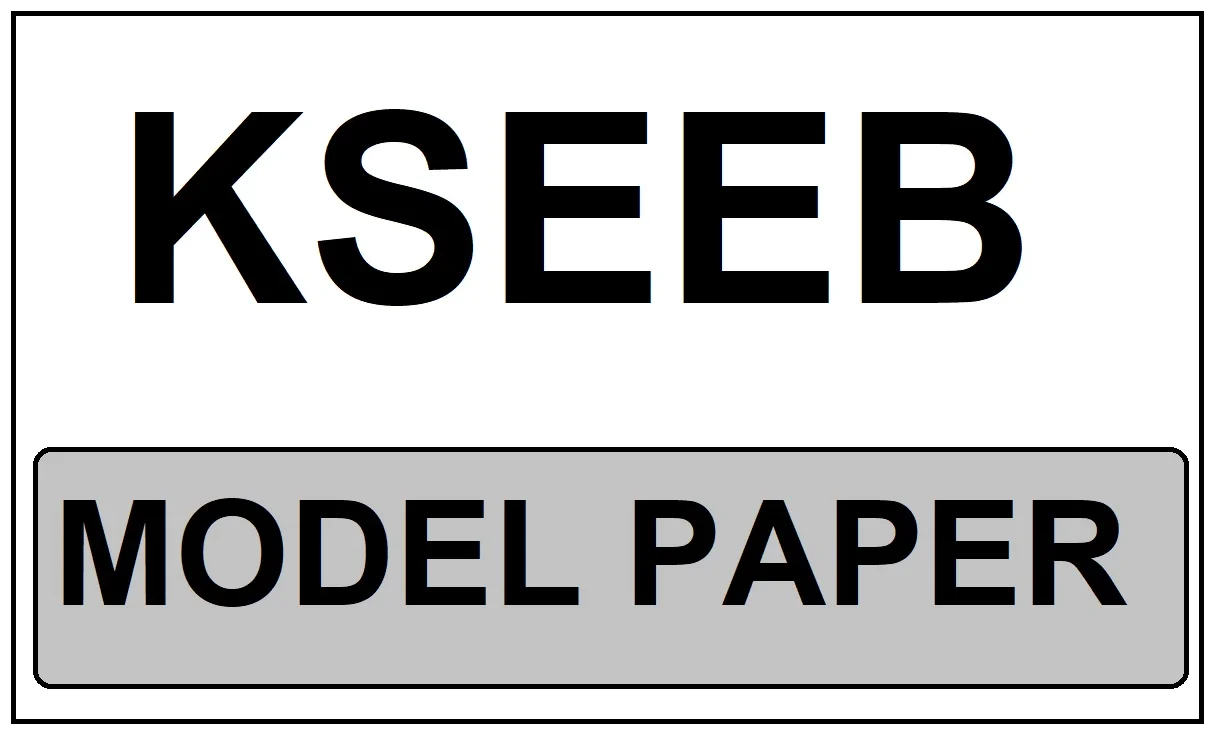
SCERT Karnataka Question Paper 2024 Class 1
- New Exam Scheme or Question Pattern for Sammittive Assignment Exams (SA1 & SA2): Very Long Answer (VLA), Long Answer (LA), Small Answer (SA), Very Small Answer (VSA), Single Answer, Multiple Choice and etc.
- New Exam Scheme or Question Pattern for Formative Assignment Exams (FA1, FA2, FA3, FA3) : Reflex, NoteBook (Class Work), Project Work, and Slip Test.
- Type of Study Material: Previous Papers, Guess Papers, Old Exam Question Bank, Solved Question Bank, Mock Test Questions, Practice Questions, Important Questions and etc.
- Syllabus of Course : Newly Revised Syllabus & Curriculum by the Education Board.
- KSEEB Class 1 Model Paper 2024 Pdf Download available websites: https://sslc.karnataka.gov.in/
How to Download SCERT Kar 1st Class Model Paper 2024
- Visit the Karnataka State Education Board Official Website at https://sslc.karnataka.gov.in/
- Select the ‘ Publication ‘ Option from the Main menu options.
- Then you have redirected to the main page of download and Continue.
- Choose ‘ Your Course as Class 1 ‘, and Select ‘ Question Bank ‘ or ‘ Model Paper ‘.
- Select ‘ Class 1 ‘ to download the academic Question Bank.
- Finally, KSEEB Model Paper 2024 Class 1 Pdf will be Downloaded for all Languages & Subjects of the Course.
SCERT Karnataka STD-I Model Paper 2024
Ncert sample paper 2024 class 1 for karnataka, kseeb model paper 2024 class 1 pdf download.
- Class 1 Practice Worksheet Suggested by Delhi Public School – Download
- PP1/KG1 Combined Worksheet issued by DPS – Download
- Class 1 Assessment Question Paper – Download
- KSEEB PP1/KG1 Active Star Question Paper – Download
- English Question Paper – Download
- Maths Question Paper – Download
- KSEEB Class 1 Syllabus – Download
- KSEEB Class 1 Book – Download
- KSEEB Class 1 Model Paper – Download
Related Posts:
- Kar SSLC Model Paper 2024, Karnataka 10th Question…
- Karnataka PUC Model Paper 2024 KAR 1st PUC & 2nd PUC…
- Karnataka SSLC Model Paper 2024 KSEEB Sample…
- Karnataka Model Paper 2024 Class 2
- Karnataka Model Paper 2024 Class 3
- Karnataka Model Paper 2024 Class 4
- Karnataka Model Paper 2024 Class 5
- Karnataka Model Paper 2024 Class 6
- Karnataka Model Paper 2024 Class 7
- Karnataka Model Paper 2024 Class 8
- Karnataka Model Paper 2024 Class 9
- Karnataka Model Paper 2024 Pdf Download
- Karnataka PUC Important Questions 2024, KAR PUC Bit…
- AHSEC HS Question Paper 2024, Assam 12th Model Paper…
- Kerala +2 Question Paper 2024, Kerala Plus Two Model…
- Bihar Board 12th Model Paper 2024, BSEB 12th…
ಸೆಟ್ಟಿಂಗ್ಗಳು
ಪಠ್ಯ ಅನುವಾದ, ಅನುವಾದ ಫಲಿತಾಂಶಗಳು, ಡಾಕ್ಯುಮೆಂಟ್ ಅನುವಾದ.

ವೆಬ್ಸೈಟ್ ಅನುವಾದ
URL ನಮೂದಿಸಿ
ಚಿತ್ರದ ಅನುವಾದ

Learn about different ways to see your students' responses, change grades, delete responses, give feedback, and close assignments.
Navigate to Responses
You can navigate to the "Responses" tab from within the formative itself or directly from the "Formatives" page
Within the formative
Click on the name of the formative you want to see
At the top of the screen, click on "Responses"

From the Fromatives page
Locate the formative on the Formatives page
On the grid of classes, click on the cell that corresponds with your class
Choose "View Responses"

Icons on the Responses tab
Icons next to student names will indicate the student's participation status (see chart below). A color-coded display of student performance on each question will appear in real time as the students enter their responses to auto-graded questions, and icons on the color-coded cells will indicate a need for the teacher's additional attantion.
Here is an example of a formative in progress on the Responses tab:

Participation Icon Chart
Response color-code and icons.
Autograded responses are color-coded based on the standard color scheme displayed below. If you are a Silver/Gold user, you have the option of adjusting these thresholds.
By system default, Red responses are incorrect (0%-24%), orange (25%-49%) and yellow (50%-74%) are partially correct, and green is correct (75%-100%).
Gray bars will appear if a student answered a question that cannot be auto-graded and requires a manual grading by the teacher. This will happen if the question does not support auto-grading (for example, an audio/video response), or if the teacher did not set an answer key for auto-grading.

Speech bubbles on the student response bars are indicators that there is feedback on that response!
Blank white spaces on a formative that has yet to be submitted signify unanswered questions. Once the formative is submitted, these blank white spaces will change color and a 🚫 symbol will appear inside the cell indicating that the response was submitted unanswered:

Formative Action Icons
The Responses tab also presents the option to take actions on the formative's assignment settings.
Click the icon presented next to the class' title to reveal the dropdown menu (could be lightning-bolt, suitcase, or calendar icons)

The dedicated help center articles elaborating on these actions are linked below, and in brief:
Additional Settings : Change the assignment settings for the formative in real-time. Note that you will need to adjust the settings for each class separately.
Force Submissions : Submits the assignment for all the students in the class, regardless of progress or completion of the formative.
Pause Assignment : Temporarily disable access to the assignment so you can clarify a point, make a change, or if class was suddenly disrupted.
Close Assignment : Unless you've allowed edits after submission, closing a formative will prevent any more responses.
The Responses tab offers multiple sorting and presentation options to organize the information displayed. Sorting order preference that is chosen will be saved and the Responses tab will continue to display this chosen order every time the teacher navigates to the Responses tab until the teacher actively changes the preference to something else.
Top Menu Options
The menu at the top of the page gives you the option to Group by standards to see how your students performed on the assessment according to tagged standards. Simply toggle on the button for the view to adjust accordingly.

Clicking the "Settings" button will display the options to:
Change between viewing scores by percent or by points
Show or hide responses by archived students
Hide student names (Silver/Gold feature): Protect privacy if you're sharing your screen. Use this in tandem with randomized student sorting for added privacy.

Clicking the "Sort By" button at the top right corner will give you a wide arrey of sorting options.
By default your view will sort by "Active" students first (active students are those who have the formative open on their devices at that particular moment, they will also have a green live indicator next to their avatar to indicate they are active).
Other sorting options include: by student name (first or last, A-Z or Z-A), by submission date or by scores. Silver/Gold users can also randomize the list's order.
Filter Responses
The main view of the "Responses" tab displays all your students' overall performance on a formative. From this "Totals" view you have the option to drill down further and view all student responses for a single question, or zero-in on a single student's response. In this section you can read about:
Viewing all responses/scores for a formative
Viewing responses/scores for specific questions
Viewing one student's responses/scores
Viewing responses sorted by standards is covered in this article .
View all responses/scores for a formative:
The "Responses" tab will initially open on the "Totals" view, which looks like this:

The average score for questions is shown at the top to give you an idea of how the class is doing with each question. All students show up under their class/org and their performance is displayed on the grid next to their names. From here you can navigate to other views as described in the following sections of this article.
If you've enabled multiple attempts (retakes) on the formative, only the latest attempt will count as the final one and its' score will be returned to the student and counted toward data reporting. This "Totals" view is where you will be able to view how each student did on all the attempts they've taken previously and if needed you will be able to adjust the scores on the final attempt based on your observations of the previous attempts (for example if you'd like to give a student extra credit for effort). Whatever score you manually enter will over-ride the system's auto-scoring and will be both returned to the student as their final score and included in data reporting.
Viewing all attempts by a student
Navigate to your formative's Responses tab
Locate the student whose work you want to view
Click on the small downward arrow next to the student's name
All the student's attempts will display in descending order, with the latest attempt at the top and the first attempt at the bottom
Only the latest / final attempt will be returned to the student and taken into account for data reporting
You can click on individual cells to view the answers entered for each question on each of the attempts. Full answers will be expanded to display on a right-side panel.

View responses/scores for a specific question:
From the "Totals" view click on any single question number at the top of the grid and you'll be redirected to the specific question's gallery view. This gallery view displays all student responses for that particular question only. This view also allows you to see your students' responses as they enter them in real-time!
From this view you can also select individual responses or multiple responses by check-marking the checkbox within the response tiles, and perform actions such as sending feedback, manually grading, and more (continue reading to learn about these options!)
View Question Details
Clicking the 3 vertical dots next to the question prompt on the far right will present you with a dropdown menu that offers the options to zoom responses in or out, as well as show the question details, i.e. the correct answer(s), the point value, and the standards tagged to the question.
View response by individual student
By clicking on an individual student response tile - either from the main "Totals" view or from the individual question Gallery view - a right-side panel will open on your screen, allowing you to interact with that student's response. From this window you can adjust scores manually, send your student real-time or delayed feedback, and even clear the student's response if needed.
Clicking the sideways arrows next to the question number at the top left corner of this right-side panel will allow you to navigate to the previous or the next question to view the response to it by the same student.
Alternatively, clicking the up or down arrows around a student's name within the right-side panel will allow you to navigate to the previous or next student in your class roster to view their response to the same question.
You can enlarge the right-side panel to full screen, which is helpful for checking longer answers like Drawings or long Free Responses. Click on the square icon at the top of the panel to enter full-screen mode for a single response.
Student question attempt count
If you set your formative to return scores instantly on auto-graded questions that do not require keyboard entries, students will have the option to check if their answer is correct as they take the formative. Formative will record the amount of attempts made by the student and will display the number of attempts on the answer tiles in this view

Frequency Chart
From this singular question view, you can also open the Responses Frequency Chart. This allows you to see how many students gave a particular response to a question. To access the Frequency chart view, click the "Frequency" button to view the Frequency chart which will present you with additional response data for the following question types:
Multiple Choice
Multiple Selection
Inline Choice
Using the "Filters" button you can define which classes to showcase in the Frequency Chart. You can choose to view the results for one class, a few classes, or all at the same time. You can also toggle the "save filters" button at the bottom of the panel to save your filters as the default moving forward (or turn the default off by un-toggling it).
Use the Settings button to set your desired results parameters. You can choose to:
View scores by points or percentages
Hide or show student names
Show or hide archived students
Show Overall Bar
Show overall average
Show filtered average

Within the Frequency Chart view you can hover over the frequency bar to reveal the class name, the response percentage and the student count for each of the response options.
Clicking on the bars within the frequency chart will open the right side panel where you can view the full list of students who provided this response, adjust everyone's score at once, send them all instant or delayed feedback at once, or even remove their responses if needed.

Any answers that received Partial Credit are also marked clearly on the frequency chart with a yellow indicator:

View responses from one individual student too all questions
You can look at a singular student's submission for all question on a formative in one view as well. This is helpful if you want to grade one student at a time or go over an assignment with an individual student.
From the Responses tab, click on the student's name or on the total points/percentage cell next to their name.
A side panel will appear with their responses and scores.
Scroll to see all of that student's responses.
View responses by class and guest students
If you have assigned a formative to multiple classes, they will each show separately on the Responses tab. Students for each class will be nested under their class heading.
If "guest students" completed the formative, those results will be visible under "Guest Students." Guests are not associated with a class and therefore appear in a separate list.
Please note: We do not recommend using guest codes with students who have a formative account as guest logins are temporary, one-use logins. Guest students can not access the formative again once they've exited it, and if deleted - their scores can not be restored. Please have your students log in using their account credentials, and use guest codes only if absolutely necessary.

Change scores
If you created an answer key for a question, it will automatically be scored on the Responses tab. You can change the score or, as a Silver/Gold user, add answers to the answer key for certain question types.
Click on a single student's response to expand it to the right-side panel. From there you can type in a score out of the total number of points, or simply move the score bar.
Silver/Gold users can also add manually-graded responses to the answer key with a single click. This will update your answer key so that other students with the same response are auto-graded as correct!
As a reminder, if you've enabled multiple attempts (retakes) on the formative, only the latest attempt will count as the final one and its' score will be returned to the student and counted toward data reporting. To change the final score for students you will need to adjust the question's score on the latest attempt made by the student as changing it on any other attempts will not effect the final score. Whatever score you manually enter to the latest attempt will over-ride the system's auto-scoring and will be both returned to the student as their final score and included in data reporting.
Note: An answer key must have been defined on a question for the system to offer you to add another response to it from this view. If you haven't defined an answer key for auto-grading in advance, you will need to manually choose the student responses and grade them. You can use Group Scoring (see below)
Group scoring.
We have recently introduced a new design to this capability! Instead of clicking the circle next to the students' names, a checkbox will appear on the top right corner of the student's response card to check-mark and multi-select students. In the meanwhile:
Manually scoring students one by one can be a daunting mission. Formative makes it easier and faster by allowing the teacher to select a group of students and score them with one click!
Click a specific question number.
Check the check box next to the students' names for all the responses you'd like to group score, or click "all" to select all students for that question. You can also hold down Ctrl or Cmnd on your keyboard to multi-select response cards.
Adjust the score in the right-side panel, and all responses chosen will be scored at once!
NOTE: Multi-select will only pick up students from classes with an expanded view. If you're scoring multiple classes at once, expand the view for all the classes you're scoring to include the students in the multi-select.
Give Feedback
From the Responses tab, you can comment on an individual response or, if you are a Silver/Gold user, give group feedback.
To give feedback for one response, click on that answer. A side panel will appear with the student's response and score. Type your message into the "feedback" section at the bottom of the panel. To make sending feedback even quicker and easier, your three most recent unique feedback messages will be displayed below the feedback section, you can click on any of them to quickly enter them into the feedback section. No worries, you will have the option to edit them before hitting "send".
You can also pin recent feedback messages you want to pop-up for you as options every time! Simply click the small pin icon:

Feedback appears to the student as a notification and they can respond to it in Formative as long as the assignment is still open or if you allow them to view after submission. (These are options that can be adjusted in the Additional Assign Settings .) You can delay feedback if you want to type it now but have it appear later, for instance after the assignment is closed.
Group feedback, a Silver/Gold feature, can be sent to multiple students by selecting multiple response tiles simultaneously:
Check the check box next to the names of the students you'd like to send group feedback to, or click "all" to select all students for that question. You can also hold down Ctrl or Cmnd on your keyboard to multi-select response cards.
Type your feedback and hit send (or select "Delayed feedback" before sending if you wish).
When feedback has been sent or received an icon will appear on the response bubble. You can easily tell who sent the last feedback message, the teacher or the student, by the color of the icon: Red icons will appear when the last message is from the student, and Blue icons will appear when the last message is from the teacher.

Feedback on formatives with Retakes enabled
Any feedback message you send to your students or receive from them on an individual question while taking a formative that has retakes enabled on it - on any of the attempts - will carry over to all the following attempts. This will allow both you and the student to maintain a flow of communication throughout the whole process - from the moment the formative is assigned until the student has finished taking all possible attempts:
Remove a Response
You can remove a student's response to the entire formative at once or to individual questions.
Remove an individual response by a student
Click on the individual response to open it on the right-side panel (this can be either from the response-tiles gallery view or from the responses grid)
Click on the triple dot menu within the right-side panel
Choose "Clear Response" from the dropdown menu

Remove all responses for a student:
From your main responses tab, click on the student to expand their full submission in the right side panel
Click on the triple dot menu within the right side panel
Choose "Remove Responses" from the dropdown menu

Force-submit assignments
Submissions.
When students complete a formative, they are given a prompt to submit it. You can watch students answer in real time from the Responses tab. There will be a green checkmark next to their name once they have submitted the assignment.
If a student did not submit the formative for any reason, you can submit it on their behalf.
Force-submit for individual students
To force submit for one student, click on that student's name. From the side panel, select the dropdown and then select "Force submission."
Force-submit for the entire class or multiple classes
Select the lightning bolt icon next to the class name.
From the dropdown, select "Force submissions."
A pop-up will appear with options:
"Grade empty responses zero": You can have unanswered questions automatically graded as zeroes or leave them ungraded.
Select students: Students who did not submit will be automatically selected. If you select all and have opted to mark unanswered questions as zero, it will ensure that even those who submitted will have their unanswered questions auto-graded.
Click "Submit" to confirm.
You will be prompted to proceed and given the option to change your selection for grading empty responses zero. Click proceed.
Unsubmit an assignment
You can unsubmit individual student formatives if you wish to allow them to retake an assignment:
From the main Responses tab, making sure you are on the "Totals" view - click on the student whose work you want to unsubmit
Within the right side panel, click on the triple dot menu
Choose "Undo Submission" and proceed to confirm
Close an assignment
Closing the assignment will execute the additional assign settings for closed assignments. More about how to close a formative and troubleshooting is in this article .
From the Responses tab, you can close an assignment by clicking on the lightning bolt dropdown and selecting "Close assignment."
If the assignment has a red padlock icon, it means it's already closed. You can reopen it if you need to by following the same steps and selecting "Open assignment."
Closing the assignment will not automatically force submit so if you open it again, it will allow students who did not submit to complete their formative.
Closing an assignment with Retakes enabled
When a a formative is closed, the formative will close at that time for all assigned students, regardless of the number of attempts they managed to take by that time.
What's next?
Enable re-dos and retakes
View responses grouped by standards
- kannadadeevige.in
- Privacy Policy
- Terms and Conditions
- DMCA POLICY
Sign up for Newsletter
Signup for our newsletter to get notified about sales and new products. Add any text here or remove it.
- 8th Standard
- ವಿರುದ್ಧಾರ್ಥಕ ಶಬ್ದಗಳು
- ಕನ್ನಡ ವ್ಯಾಕರಣ
- ದೇಶ್ಯ-ಅನ್ಯದೇಶ್ಯಗಳು
- ಕನ್ನಡ ನಿಘಂಟು
- ಭೂಗೋಳ-ಸಾಮಾನ್ಯಜ್ಞಾನ
- ಭಾರತದ ಇತಿಹಾಸ-ಸಾಮಾನ್ಯ ಜ್ಞಾನ
- ಕನ್ನಡ ಕವಿ, ಕಾವ್ಯನಾಮಗಳು
- Information
- Life Quotes
- Education Loan
ಇದರಲ್ಲಿ 50+ ಕನ್ನಡ ಪ್ರಬಂಧಗಳು ಇದರಲ್ಲಿವೆ, Kannada Prabandhagalu, Kannada prabandha, Prabandha in Kannada, ಪ್ರಬಂಧ ವಿಷಯಗಳು Kannada Prabandha List
Prabandha in Kannada
ಆತ್ಮೀಯರೇ.. ಈ ಲೇಖನದಲ್ಲಿ ನಾವು ಪ್ರಬಂಧ ವಿಷಯಗಳನ್ನು ಇಲ್ಲಿ ಕೊಟ್ಟಿದ್ದೇವೆ. ನಿಮಗೆ ಬೇಕಾದ ಪ್ರಬಂಧದ ಮೇಲೆ ಕ್ಲಿಕ್ ಮಾಡಿ ಸಂಪೂರ್ಣ ಪ್ರಬಂಧವನ್ನು ನೀವು ನೋಡಬಹುದು
ಕುವೆಂಪು ಅವರ ಜೀವನ ಚರಿತ್ರೆ ಪ್ರಬಂಧ
ಸಾಂಕ್ರಾಮಿಕ ರೋಗ ಪ್ರಬಂಧ, ಬದುಕುವ ಕಲೆ ಪ್ರಬಂಧ ಕನ್ನಡ , ಗ್ರಂಥಾಲಯದ ಮಹತ್ವ ಪ್ರಬಂಧ, ಗಾಂಧೀಜಿಯವರ ಬಗ್ಗೆ ಪ್ರಬಂಧ, ದೀಪಾವಳಿಯ ಬಗ್ಗೆ ಪ್ರಬಂಧ, ಕೋವಿಡ್ ಮಾಹಿತಿ ಪ್ರಬಂಧ, ಜಾಗತೀಕರಣದ ಬಗ್ಗೆ ಪ್ರಬಂಧ , ಪರಿಸರ ಸಂರಕ್ಷಣೆ ಪ್ರಬಂಧ, ಪ್ರಜಾಪ್ರಭುತ್ವದಲ್ಲಿ ಮತದಾರರ ಪಾತ್ರ ಪ್ರಬಂಧ, ಸ್ವಚ್ಛ ಭಾರತ ಅಭಿಯಾನ ಬಗ್ಗೆ ಪ್ರಬಂಧ, ಕನ್ನಡ ರಾಜ್ಯೋತ್ಸವ ಬಗ್ಗೆ ಪ್ರ ಬಂಧ, ಕನ್ನಡ ನಾಡು ನುಡಿ ಪ್ರಬಂಧ, ಕನ್ನಡ ಭಾಷೆಯ ಬಗ್ಗೆ ಪ್ರಬಂಧ, ನನ್ನ ಫಿಟ್ನೆಸ್ ಮಂತ್ರ ಪ್ರಬಂಧ, ತಾಯಿಯ ಬಗ್ಗೆ ಪ್ರಬಂಧ, ತಂಬಾಕು ನಿಷೇಧ ಪ್ರಬಂಧ, ಮಕ್ಕಳ ಸಾಗಾಣಿಕೆ ವಿರುದ್ಧ ಪ್ರಬಂಧ, ಕನಕದಾಸರ ಬಗ್ಗೆ ಪ್ರಬಂಧ, ಕೃಷಿ ಬಗ್ಗೆ ಪ್ರಬಂಧ, ಪರಿಸರ ಸಂರಕ್ಷಣೆಯಲ್ಲಿ ವಿದ್ಯಾರ್ಥಿಗಳ ಪಾತ್ರ ಪ್ರಬಂಧ, ಮಾನಸಿಕ ಆರೋಗ್ಯ ಪ್ರಬಂಧ, ಭಾರತದ ಸ್ವಾತಂತ್ರ್ಯ ಸಂಗ್ರಾಮ ಪ್ರಬಂಧ, ರಾಷ್ಟ್ರೀಯ ಮತದಾರರ ದಿನಾಚರಣೆ ಪ್ರಬಂಧ, ಭಾರತದ ಚುನಾವಣಾ ವ್ಯವಸ್ಥೆ ಪ್ರಬಂಧ, ಪರಿಸರ ಮಹತ್ವ ಪ್ರಬಂಧ, ಗೆಳೆತನದ ಬಗ್ಗೆ ಪ್ರಬಂಧ, ಪ್ರಜಾಪ್ರಭುತ್ವದಲ್ಲಿ ಯುವಕರ ಪಾತ್ರ ಪ್ರಬಂಧ, ಮಕ್ಕಳ ಹಕ್ಕುಗಳ ಬಗ್ಗೆ ಪ್ರಬಂಧ, ಮಕ್ಕಳ ದಿನಾಚರಣೆ ಬಗ್ಗೆ ಪ್ರಬಂಧ, ಕನ್ನಡ ಕವಿಗಳು ಕಂಡ ಸೂರ್ಯೋದಯದ ವರ್ಣನೆ ಪ್ರಬಂಧ, ನಿರುದ್ಯೋಗ ಸಮಸ್ಯೆ ಪ್ರಬಂಧ, ನನ್ನ ಕನಸಿನ ಭಾರತ ಪ್ರಬಂಧ, ಮತದಾನ ಪ್ರಬಂಧ, ಸಮೂಹ ಮಾಧ್ಯಮ ಪ್ರಬಂಧ, ರಾಷ್ಟ್ರೀಯ ಹಬ್ಬಗಳ ಮಹತ್ವ ಪ್ರಬಂಧ, ಕನ್ನಡ ನಾಡಿನ ಹಿರಿಮೆ ಪ್ರಬಂಧ, ದಸರಾ ಬಗ್ಗೆ ಪ್ರಬಂಧ, ಜಲ ವಿದ್ಯುತ್ ಬಗ್ಗೆ ಪ್ರಬಂಧ, ಕನ್ನಡ ಭಾಷೆಯನ್ನು ಉಳಿಸುವಲ್ಲಿ ಕನ್ನಡಿಗರ ಪಾತ್ರ ಪ್ರಬಂಧ, ಗಣರಾಜ್ಯೋತ್ಸವ ಪ್ರಬಂಧ, ನೀರಿನ ಅವಶ್ಯಕತೆ ಪ್ರಬಂಧ, ಚುನಾವಣೆಯಲ್ಲಿ ಯುವಕರ ಪಾತ್ರ ಪ್ರಬಂಧ, ಫಿಟ್ ಇಂಡಿಯಾ ಬಗ್ಗೆ ಪ್ರಬಂಧ, ನನ್ನ ಜೀವನದ ಗುರಿ ಬಗ್ಗೆ ಪ್ರಬಂಧ, ಭಾರತೀಯ ಸೇನೆಯ ಬಗ್ಗೆ ಪ್ರಬಂಧ, ಕರ್ನಾಟಕದ ಬಗ್ಗೆ ಪ್ರಬಂಧ, ಅರಣ್ಯ ಸಂರಕ್ಷಣೆ ಪ್ರಬಂಧ, ಇ-ಗ್ರಂಥಾಲಯದ ಬಗ್ಗೆ ಪ್ರಬಂಧ, ಆರೋಗ್ಯಕರ ಜೀವನಶೈಲಿ ಕುರಿತು ಪ್ರಬಂಧ, ಶಿಕ್ಷಣದಲ್ಲಿ ತಂತ್ರಜ್ಞಾನದ ಕೊಡುಗೆ ಪ್ರಬಂಧ, ಡಿಜಿಟಲ್ ಇಂಡಿಯಾ ಕುರಿತು ಪ್ರಬಂಧ, ರಾಷ್ಟ್ರ ನಿರ್ಮಾಣದಲ್ಲಿ ಯುವಕರ ಪಾತ್ರ ಪ್ರಬಂಧ, ಡಿಜಿಟಲ್ ಮಾರ್ಕೆಟಿಂಗ್ ಬಗ್ಗೆ ಪ್ರಬಂಧ, ವನ್ಯಜೀವಿಗಳ ಸಂರಕ್ಷಣೆ ಬಗ್ಗೆ ಪ್ರಬಂಧ, ತ್ಯಾಜ್ಯ ನಿರ್ವಹಣೆ ಬಗ್ಗೆ ಪ್ರಬಂಧ, ಸಂವಿಧಾನ ಪ್ರಬಂಧ, ಕನ್ನಡ ಭಾಷೆಯ ಮಹತ್ವ ಪ್ರಬಂಧ, ಭ್ರಷ್ಟಾಚಾರ ನಿರ್ಮೂಲನೆಯಲ್ಲಿ ವಿದ್ಯಾರ್ಥಿಗಳ ಪಾತ್ರ ಪ್ರಬಂಧ, ಸಮಯದ ಮಹತ್ವ ಪ್ರಬಂಧ, ಮತದಾನ ಪ್ರಬಂಧ , ಪ್ರವಾಸೋದ್ಯಮದ ಬಗ್ಗೆ ಪ್ರಬಂಧ, ಸೈಬರ್ ಕ್ರೈಮ್ ಬಗ್ಗೆ ಪ್ರಬಂಧ, ಭ್ರಷ್ಟಾಚಾರ ಮುಕ್ತ ಭಾರತ ಪ್ರಬಂಧ, ಇಂಟರ್ನೆಟ್ ಅಡಿಕ್ಷನ್ ಕುರಿತು ಪ್ರಬಂಧ, ಇ-ಶಾಪಿಂಗ್ ಕುರಿತು ಪ್ರಬಂಧ, ಅಂತರ್ಜಾಲದ ಕುರಿತು ಪ್ರಬಂಧ, ಮಹಿಳಾ ಶಿಕ್ಷಣ ಪ್ರಬಂಧ, ಸಂವಿಧಾನ ದಿನಾಚರಣೆ ಪ್ರಬಂಧ, ಶಬ್ದ ಮಾಲಿನ್ಯ ಬಗ್ಗೆ ಪ್ರಬಂಧ, ಆದರ್ಶ ಶಿಕ್ಷಕ ಪ್ರಬಂಧ, ಸಮಾಜದಲ್ಲಿ ಮಾಧ್ಯಮದ ಪಾತ್ರ ಪ್ರಬಂಧ, ಆನ್ಲೈನ್ ಶಿಕ್ಷಣ ಪ್ರಬಂಧ, ಪ್ಲಾಸ್ಟಿಕ್ ನಿಷೇಧದ ಕುರಿತು ಪ್ರಬಂಧ, ನೈಸರ್ಗಿಕ ವಿಕೋಪ ಪ್ರಬಂಧ, ಮೊಬೈಲ್ ದುರ್ಬಳಕೆಯ ಬಗ್ಗೆ ಪ್ರಬಂಧ, ಮಣ್ಣಿನ ಬಗ್ಗೆ ಪ್ರಬಂಧ, 2047ಕ್ಕೆ ನನ್ನ ದೃಷ್ಟಿಯಲ್ಲಿ ಭಾರತ, ಜನಸಂಖ್ಯೆ ಪ್ರಬಂಧ, ನಿರುದ್ಯೋಗ ಪ್ರಬಂಧ, ಸಾಮಾಜಿಕ ಪಿಡುಗುಗಳು ಪ್ರಬಂಧ, ಕನ್ನಡ ರಾಜ್ಯೋತ್ಸವ ಬಗ್ಗೆ ಪ್ರಬಂಧ, ಮಕ್ಕಳ ಹಕ್ಕುಗಳ ಬಗ್ಗೆ ಪ್ರಬಂಧ ಹಾಗು ಮಾಹಿತಿ, ಭೂ ಮಾಲಿನ್ಯ ಕುರಿತು ಪ್ರಬಂಧ, ಬದುಕುವ ಕಲೆ ಪ್ರಬಂಧ ಕನ್ನಡ pdf, ಕನಕದಾಸ ಜಯಂತಿ ಬಗ್ಗೆ ಪ್ರಬಂಧ, ಭಾರತದ ಸ್ವಾತಂತ್ರ್ಯ ದಿನಾಚರಣೆಯ ಬಗ್ಗೆ ಪ್ರಬಂಧ, ಭಾರತದ ಸ್ವಾತಂತ್ರ್ಯ ಚಳುವಳಿ ಬಗ್ಗೆ ಪ್ರಬಂಧ, ಸ್ವಾತಂತ್ರ್ಯ ಹೋರಾಟದಲ್ಲಿ ಮಹಿಳೆಯರ ಪಾತ್ರ ಪ್ರಬಂಧ, ಸ್ವಾತಂತ್ರ್ಯ ಭಾರತದ ಸಾಧನೆಗಳು ಪ್ರಬಂಧ, 75 ಸ್ವಾತಂತ್ರ್ಯ ನಂತರದ ಭಾರತ ಪ್ರಬಂಧ, ಪರಿಸರ ಸಂರಕ್ಷಣೆ ನಮ್ಮೆಲ್ಲರ ಹೊಣೆ ಪ್ರಬಂಧ, ಜವಾಹರಲಾಲ್ ನೆಹರು ಅವರ ಬಗ್ಗೆ ಪ್ರಬಂಧ, ಸ್ವಾತಂತ್ರ್ಯೋತ್ಸವದ ಬಗ್ಗೆ ಪ್ರಬಂಧ, ರಾಷ್ಟ್ರಧ್ವಜದ ಕುರಿತು ಪ್ರಬಂಧ, ಸ್ವಾತಂತ್ರ್ಯ ಹೋರಾಟದಲ್ಲಿ ಗಾಂಧೀಜಿಯವರ ಪಾತ್ರ ಪ್ರಬಂಧ, ಆಜಾದಿ ಕಾ ಅಮೃತ ಮಹೋತ್ಸವ ಪ್ರಬಂಧ, ಸ್ವಾತಂತ್ರ್ಯೋತ್ಸವದ ಅಮೃತ ಮಹೋತ್ಸವ ಪ್ರಬಂಧ, ಸ್ವಾತಂತ್ರ್ಯ ಭಾರತದ ಅಭಿವೃದ್ಧಿ ಕುರಿತು ಪ್ರಬಂಧ, ಸ್ವಾತಂತ್ರ್ಯ ನಂತರದ ಭಾರತ ಪ್ರಬಂಧ ಕನ್ನಡ, ಯೋಗದ ಮಹತ್ವದ ಬಗ್ಗೆ ಪ್ರಬಂಧ, ವರದಕ್ಷಿಣೆ ಪ್ರಬಂಧ, ವಿಶ್ವ ಪರಿಸರ ದಿನಾಚರಣೆ ಪ್ರಬಂಧ, ವಿಶ್ವ ಯೋಗ ದಿನಾಚರಣೆ ಪ್ರಬಂಧ, ಅಂಬೇಡ್ಕರ್ ಬಗ್ಗೆ ಪ್ರಬಂಧ, ಶಾಲೆಯ ಬಗ್ಗೆ ಪ್ರಬಂಧ ಕನ್ನಡ, ಪುನೀತ್ ರಾಜ್ ಕುಮಾರ್ ಬಗ್ಗೆ ಪ್ರಬಂಧ, ಪರಿಸರ ಸಂರಕ್ಷಣೆ ಇಂದಿನ ಅಗತ್ಯ ಪ್ರಬಂಧ, ಶಕ್ತಿ ಸಂರಕ್ಷಣೆ ಪ್ರಾಮುಖ್ಯತೆ ಪ್ರಬಂಧ, ಇಂಧನ ಉಳಿತಾಯ ಪ್ರಬಂಧ, ಮಹಿಳಾ ಹಕ್ಕುಗಳ ಕುರಿತು ಪ್ರಬಂಧ, ಪ್ರಬಂಧ ಬರೆಯುವುದು ಹೇಗೆ, ರೈತರ ಆತ್ಮಹತ್ಯೆ ಕುರಿತು ಪ್ರಬಂಧ, ವಿದ್ಯಾರ್ಥಿ ಜೀವನ ಪ್ರಬಂಧ, ಮಾತೃಭಾಷೆಯಲ್ಲಿ ಶಿಕ್ಷಣ ಪ್ರಬಂಧ, ಮೂಢನಂಬಿಕೆ ಬಗ್ಗೆ ಪ್ರಬಂಧ, ನೇತ್ರದಾನದ ಮಹತ್ವ ಪ್ರಬಂಧ, ಕೋವಿಡ್ ಮುಂಜಾಗ್ರತೆ ಕ್ರಮಗಳು ಪ್ರಬಂಧ, ವಾಯು ಮಾಲಿನ್ಯ ಬಗ್ಗೆ ಪ್ರಬಂಧ, ಜಲಮಾಲಿನ್ಯದ ಬಗ್ಗೆ ಪ್ರಬಂಧ, ನೋಟು ಅಮಾನ್ಯೀಕರಣ ಮತ್ತು ಕಪ್ಪು ಹಣ ಪ್ರಬಂಧ, ನಾನು ಈ ರಾಜ್ಯದ ಮುಖ್ಯಮಂತ್ರಿ ಆದರೆ ಪ್ರಬಂಧ, ಸಂಗೊಳ್ಳಿ ರಾಯಣ್ಣನ ಬಗ್ಗೆ ಪ್ರಬಂಧ, ಸುಭಾಷ್ ಚಂದ್ರ ಬೋಸ್ ಅವರ ಬಗ್ಗೆ ಪ್ರಬಂಧ, ನೀರು ಮತ್ತು ನೈರ್ಮಲ್ಯ ಪ್ರಬಂಧ, ಮಕರ ಸಂಕ್ರಾಂತಿ ಹಬ್ಬದ ಬಗ್ಗೆ ಪ್ರಬಂಧ, ಮತದಾನದ ಮೂಲಕ ಪ್ರಜಾಪ್ರಭುತ್ವದಲ್ಲಿ ಬದಲಾವಣೆ ಪ್ರಬಂಧ, ನೀರಿನ ಸಂರಕ್ಷಣೆ ಪ್ರಬಂಧ, ಸ್ವಾಮಿ ವಿವೇಕಾನಂದರ ಬಗ್ಗೆ ಪ್ರಬಂಧ, ಅಸ್ಪೃಶ್ಯತೆ ಒಂದು ಸಾಮಾಜಿಕ ಪಿಡುಗು ಪ್ರಬಂಧ, ಮಹಿಳಾ ಸಬಲೀಕರಣ ಪ್ರಬಂಧ, ಅಬ್ದುಲ್ ಕಲಾಂ ಅವರ ಬಗ್ಗೆ ಪ್ರಬಂಧ, ಮಾದಕ ವಸ್ತು ಸೇವನೆಯ ದುಷ್ಪರಿಣಾಮಗಳ ಬಗ್ಗೆ ಪ್ರಬಂಧ, ದೂರದರ್ಶನದ ಬಗ್ಗೆ ಪ್ರಬಂಧ, ರೈತರ ಬಗ್ಗೆ ಪ್ರಬಂಧ, ಪ್ಲಾಸ್ಟಿಕ್ ತ್ಯಾಜ್ಯ ನಿರ್ವಹಣೆ ಬಗ್ಗೆ ಪ್ರಬಂಧ, ಸೂರ್ಯನ ಬಗ್ಗೆ ಪ್ರಬಂಧ, ವರದಕ್ಷಿಣೆ ಒಂದು ಸಾಮಾಜಿಕ ಪಿಡುಗು ಪ್ರಬಂಧ, ಹೆಣ್ಣು ಮಕ್ಕಳಿಗೆ ಸರ್ಕಾರದ ಸೌಲಭ್ಯಗಳು ಪ್ರಬಂಧ, ಸರ್.ಎಂ. ವಿಶ್ವೇಶ್ವರಯ್ಯನವರ ಬಗ್ಗೆ ಪ್ರಬಂಧ, ಶಿಕ್ಷಕರ ಬಗ್ಗೆ ಪ್ರಬಂಧ, ಅತಿವೃಷ್ಟಿ ಅನಾವೃಷ್ಟಿ ಪ್ರಬಂಧ, ಯುದ್ಧ ಪ್ರಬಂಧ, ಸಾವಯವ ಕೃಷಿ ಬಗ್ಗೆ ಪ್ರಬಂಧ, ಪುಸ್ತಕಗಳ ಮಹತ್ವ ಪ್ರಬಂಧ, ರಾಷ್ಟ್ರೀಯ ಭಾವೈಕ್ಯತೆ ಪ್ರಬಂಧ, ಗ್ರಾಮ ಸ್ವರಾಜ್ಯ ಪ್ರಬಂಧ ಕನ್ನಡ, ಬಾಲ ಕಾರ್ಮಿಕ ಪದ್ಧತಿ ಪ್ರಬಂಧ, ಪರಿಸರ ಮಾಲಿನ್ಯ ಬಗ್ಗೆ ಪ್ರಬಂಧ, 19 thoughts on “ 400+ kannada prabandhagalu | ಕನ್ನಡ ಪ್ರಬಂಧಗಳು | prabandha in kannada ”.
ಗ್ರಾಮಸ್ವರಾಜ್ಯ
ಪುಸ್ತಕಗಳ. ಮಹತ್ವ
ರಕ್ತದಾನ ಮತ್ತು ನೇತ್ರದಾನ ಮಹತ್ವ
ಇದು ಬಹಳ ಉಪಯೋಗವಿದೆ
Super infomation
Super information
Kannada eassy on school
Really thanks
Realy super
Thanks good information
Thank you it helps a lot
ತುಂಬಾ ಒಳ್ಳೆಯ ಪ್ರಬಂಧಗಳು 👌👌💐💐
Leave a Reply Cancel reply
Your email address will not be published. Required fields are marked *
Save my name, email, and website in this browser for the next time I comment.
assessment in Kannada ಕನ್ನಡ
- ಕಮ್ದಾಯ ⇄ assessment kannada
- ತೆರಿಗೆ ⇄ assessment kannada
- ಮಾಪನ ⇄ assessment kannada
- ವಿಮರ್ಶನ ⇄ assessment kannada
assessment in Dogri डोगरी
- लेखा-जोखा ⇄ assessment dogri
assessment in Gujarati ગુજરાતી
- કર ઇ. ની રકમ નક્કી કરવી ⇄ assessment gujarati
- કરવેરા માટે મિલકતન ી કે આવકની આકારણી કરવી ⇄ assessment gujarati
- દંડ ⇄ assessment gujarati
assessment in Hindi हिन्दी
- कर निर्धारण ⇄ assessment hindi
- मूल्य निर्धारण ⇄ assessment hindi
- मूल्यांकन ⇄ assessment hindi
- लगान ⇄ assessment hindi
assessment in Kashmiri कॉशुर
- تجزیہ،جٲیزٕ ⇄ assessment kashmiri
assessment in Maithili মৈথিলী
- अँटकर ⇄ assessment maithili
- आकलन ⇄ assessment maithili
assessment in Marathi मराठी
- आकारणी ⇄ assessment marathi
- करनिर्धारण ⇄ assessment marathi
- निर्धारण ⇄ assessment marathi
- निर्धारित कर ⇄ assessment marathi
- मूल्यनिर्धारण ⇄ assessment marathi
- मूल्यमापन ⇄ assessment marathi
- मूल्यांकन ⇄ assessment marathi
- मोजमाप ⇄ assessment marathi
assessment in Nepali नेपाली
- मुल्याड्कन ⇄ assessment nepali
- मूल्याङ्कन ⇄ assessment nepali
assessment in Punjabi ਪੰਜਾਬੀ
- ਬਾਚ ⇄ assessment punjabi
assessment in Sindhi سنڌي
- ڍل، محصول، خراج ⇄ Assessment sindhi
assessment in Telugu తెలుగు
- పన్ను ⇄ assessment telugu
- వరి. బేరీజు. ⇄ assessment telugu
assessment in English
- assessment ⇄ assessment , noun. 1. the act of assessing. Ex. (Figurative.) Every assessment of loyalty involves a subjective element (Bulletin of Atomic Scientists). 2. the amount of tax which is decided to be payable. 3. an official valuation english
assessment Deals on Amazon
Assessment in kannada.
assessment | Kannada dictionary translates English to Kannada and Kannada to English assessment words assessment phrases with assessment synonyms assessment antonyms assessment pronunciations .
assessment meaning in Kannada
assessment in Kannada Kannada of translation of assessment Kannada meaning of assessment what is assessment in Kannada dictionary definition, antonym, and synonym of assessment
Thesaurus: Synonym & Antonym of assessment
Indian Official Languages Dictionary is significantly better than Google translation offers multiple meanings, alternate words list of assessment assessment phrases with similar meanings in Kannada ಕನ್ನಡ, Kannada ಕನ್ನಡ dictionary Kannada ಕನ್ನಡ assessment translation assessment meaning assessment definition assessment antonym assessment synonym Kannada language reference work for finding synonyms, antonyms of assessment .
This page is an online lexical resource, contains a list of the assessment like words in a Kannada language in the order of the alphabets, and that tells you what they mean, in the same or other languages including English.
What is 'assessment' meaning in Kannada?
Input a term assessment by either copy & post, drag & drop, or simply by typing in the search box. meanings of assessment will be translated.
Indian Official Languages Dictionary - KHANDBAHALE.COM | भारतीय राजभाषा शब्दकोश - खांडबहाले.कॉम is a digital dictionary platform for 22 Official Languages of India with an extensive vocabulary of 10+ million words, meanings & definitions. The languages offered along with English are Assamese (অসমীয়া) Bengali (বাংলা) Bodo (बड़ो) Dogri (डोगरी) Gujarati (ગુજરાતી) Hindi (हिन्दी) Kannada (ಕನ್ನಡ) Kashmiri (कॉशुर) Konkani (कोंकणी) Maithili (মৈথিলী) Malayalam (മലയാളം) Manipuri (মৈতৈলোন্) Marathi (मराठी) Nepali (नेपाली) Oriya (ଓଡ଼ିଆ) Punjabi (ਪੰਜਾਬੀ) Sanskrit (संस्कृतम्) Santali (ᱥᱟᱱᱛᱟᱲᱤ) Sindhi (سنڌي) Tamil (தமிழ்) Telugu (తెలుగు) Urdu (اُردُو)
To translate or to learn languages, download our Award-Winning language apps for Windows and Android devices. Download Android-based Language Apps Download Windows-based Language Softwares language services like Web-Browser Language Plug-ins. We have multiple projects going on, you are welcome to join our language projects.
- ›
- kannada-dictionary-translation-meaning-of-assessment
Get in touch with a Formative rep today.
This Website Uses Cookies By clicking “Accept”, you agree to the storing of cookies on your device to enhance site navigation, analyze site usage, and assist in our marketing efforts.
Privacy Preference Center
Privacy Preference CenterWhen you visit any website, it may store or retrieve information on your browser, mostly in the form of cookies. This information might be about you, your preferences or your device and is mostly used to make the site work as you expect it to. The information does not usually directly identify you, but it can give you a more personalized web experience. Because we respect your right to privacy, you can choose not to allow some types of cookies. Click on the different category headings to find out more and change our default settings. However, blocking some types of cookies may impact your experience of the site and the services we are able to offer.
Manage Consent Preferences
Strictly necessary cookies, always active.
These cookies are necessary for the website to function and cannot be switched off in our systems. They are usually only set in response to actions made by you which amount to a request for services, such as setting your privacy preferences, logging in or filling in forms. You can set your browser to block or alert you about these cookies, but some parts of the site will not then work. These cookies do not store any personally identifiable information. Privacy Policy .
Functional Cookies
These cookies enable the website to provide enhanced functionality and personalization. They may be set by us or by third party providers whose services we have added to our pages. If you do not allow these cookies then some or all of these services may not function properly.
Performance Cookies
These cookies allow us to count visits and traffic sources so we can measure and improve the performance of our site. They help us to know which pages are the most and least popular and see how visitors move around the site. All information these cookies collect is aggregated and therefore anonymous. If you do not allow these cookies we will not know when you have visited our site, and will not be able to monitor its performance.
Targeting Cookies
These cookies may be set through our site by our advertising partners. They may be used by those companies to build a profile of your interests and show you relevant adverts on other sites. They do not store directly personal information, but are based on uniquely identifying your browser and internet device. If you do not allow these cookies, you will experience less targeted advertising.
Instruction Assessment

Formative gives you the teaching tools to engage, instruct, and assess

(In under 2 minutes!)
Why do teachers and school leaders love formative so much, as a teacher, i will be able to..., transform a pdf or google doc into an auto-graded quiz, present slides with built-in questions for a paced lesson, enhance a reading passage with questions, activate student agency and metacognition using strikethroughs, promote higher level thinking with advanced math tools.

Create flipped instructional videos.
You can add video as a stand-alone content item and attach questions. Our Partner users can also attach questions at specific times in the video or add a video directly into any question!
You can add videos between other items on your formative. Click on the + icon in between questions or content you've already created, and select from the menu that appears.
*Note: The “Record Video” feature is not compatible with Safari on macOS.
If you are a member of a Partner School or District, you can add a video to any question or content block. You just have to click the blue "+" icon (found in any rich-text field). Then click "Video."
You will have the option to record using your camera, upload from your device, or record and upload a screencast. Check out the following animation to see how it works. Supported file types for video uploads are mp4, mov, webm, 3gpp, 3gpp2, flv, wmv, and mpeg.
You can even leave feedback for students with this feature! Just click the blue plus sign in the feedback chat box!
Add time-stamped questions to video content (Partner users only)
Partner users can create questions attached to specific times in a video. Students will see the questions pop up when the video reaches the selected time. Students are still able to control the video by playing, pausing, adjusting the time, and moving the video forward or backward.
Note: You can add more than one question at a particular timestamp by clicking the "Add item at X:XX" button, clicking the "+" in the question area, or by duplicating a question.
Students can also record video submissions when using the Free Response question type!
Can I add more than one question at the same time?
You can add more than one question at a particular timestamp by clicking the "Add item at X:XX" button, clicking the "+" in the question area, or by duplicating a question.
Can I use video timestamps during Teacher Paced Mode?
Yes! Students will see and be able to control the video in the same way during Teacher Paced Mode. Each student will be able to control the video on their own screen.
What if I want to add questions but don't want to attach them at a particular time?
Not a problem! Simply click "Add item at 0:00," and you can add your questions. Students will be able to view them ahead of time by clicking the drop-down arrow next to each question in the right-side column.
Add a YouTube video with timestamped questions
Differentiate learning with audio and video assignments..
Students can respond to your questions by recording themselves using audio and video! This is great for young learners and foreign-language classes. There is a 10-minute limit to recordings, so students will have plenty of time to share their thoughts!
To add an audio response question:
Prompt/ask students to provide a verbal response or explanation!
To add a video response question:
Prompt/ask students to provide a visual response or explanation!
Unleash student creativity with audio and video responses
See students work and engage in real-time, efficiently leave comments on student work., batch scoring & feedback:.
Score and give feedback to multiple student answers at the same time. This is useful if a particular question is giving multiple students trouble!
Draw feedback on Show Your Work Responses:
If you have a Partner account, you'll see an option to "Draw Feedback" on your students' Show Your Work responses. Click on this button to launch the full-screen canvas.
You can use any of the Show Your Work tools (draw, circle, create a square, draw a line, type, upload an image, use the Math Keyboard, select, erase, and back) to annotate your students' responses. When you click the checkmark, your annotations will be saved as an image that you can instantly send to your student as a feedback message!
Student to Teacher Feedback:
Students can directly send feedback to partner teachers on a formative and respond to teacher feedback messages.

Emojis in Student Feedback:
Have a little more fun with student feedback!
Give feedback to students faster than ever

App smash your favorite tools by embedding an external learning app

Know if students copy and paste answers.
One of our features to help ensure secure assessment is the Copy / Paste Alert. This alert is designed to show whenever a student uses any copy-and-paste function -- this could include CTRL C/V keyboard short-cuts, or right-clicking the mouse to select copy/paste, etc..
If a student has used these functions, you will see an exclamation mark alert that reads, "This response includes copy & pasted parts."

At this time, Formative shows this alert as a way to make you aware that students used this function. The only question type that will actually show you what was copied and pasted is Short Answer. You can click on the small “i” icon in the alert to view what was copied and pasted into the student response. The alert will not appear if a student copies and pastes a part of their own response: only outside items.
Teacher discretion is required for this alert, so we never auto-grade these responses as incorrect .
Some common reasons this alert will show that are not cheating might include:
- World Languages classes: copying words with special characters
- All content areas: copying parts of a question to use as a sentence starter
- Copying words that are difficult to spell from the question or another source
- Using some Chrome extensions, such as "Grammarly" to accept suggestions for their writing
It could be helpful to let your students know that you are aware when they use any copy/paste function but that this does not always indicate cheating.
Detect if students copy and paste answers
Monitor student growth against standards over time..
To access the student growth tracker, click on the Tracker tab at the top of your dashboard.

- Switch between viewing scores by Formatives or by tagged Standards.
- This area will display any filters that are currently defined. Click the pencil icon next to each of these to adjust your filter's range, or you can remove them.
- Here you will find the display area for class scores.
- Toggle this button to hide student names.
- Click the "Filter" button to define your view range by adjusting the date last answered, classes, grade levels, subjects, and Formative types. Each of the filters chosen will then appear in the area marked 2.
- Click the "Sort by" button, and sort if students will appear by their names or by their scores. You can also sort formatives by their title or by date answered.
- Click the "Export" button to export data as a CSV/Spreadsheet or asa Google Sheet (see the following for more details).
More ways to view the tracker:
When showing Formatives (at the top left), click on individual student names to view their overall score for each assignment.
Note: Students who have not yet taken a formative will have a blank score in the Tracker.
Select "Standards" to see how students performed against standards tagged in the assignments. To do so, click on "Standards," expand the standards to see them in detail (if you want), and click the student's name.

The Student Growth Tracker measures student progress over time, so it is helpful to understand how the scores are calculated.
To calculate scores, we sum up all the points that answers received (=points earned). We then total all points available for those answers (the point value on the questions = points possible) and divide the former by the latter.
For example, let's say a student completes one formative with two questions. Question one is worth five points. Question two is worth ten points. The student gets two points on the first question and six points on the second. Their score for that formative is as follows: (2 + 6)/(5 + 10) = 8/15 = 53%.
When calculating multiple formatives, we consider all questions and basically treat them as if they were one big formative. For example, let's add a formative to our previous example. This formative has one question worth five points, and the student earned four points. This student's overall grade is now as follows: (2 + 6 + 4)/(5 + 10 + 5) = 12/20 = 60%
As a result, the system will weigh a formative or question with more available points more heavily in the overall score.
NOTE: If a student did not submit an assignment, unanswered questions do not count toward possible points. When students submit an assignment with an unanswered question, their work will count towards the total possible points, thus reducing the overall score. Read about how to force-submit a formative here.
If at a later time, a teacher adds a new question that students do not answer, the tracker will not count the points for that question in their score.
Export data from the Tracker
From the Tracker page, you can select the Export button located in the top right corner.
Once you select that button, a pop-up screen will appear for you to choose the content you’d like to export. You can export as a CSV/spreadsheet or as a Google Sheet. You can also export all rows or only the rows you have expanded.
When selecting Download as CSV/Spreadsheet, it will download directly to your computer.
If you select Google Sheets, the platform will direct you to choose the email associated with your account. You will then receive a prompt to your Google Sheets page.
Monitor student growth against standards over time
Collaborate with colleagues and co-teachers, tag items to standards..
After creating a question, place your cursor over the following "Tag Standards" area, and tag your question to standards for student growth tracking! Use keywords in the dropdown menu to results with standards in their descriptions!
You can also tag a single question with multiple standards. Want us to add another standards set(s)? Please have the admin on your account reach out and let us know what standard sets(s) you would like us to add!
To add standards to a formative in your account:
- Go to your formative. In the "tag to standards" field, select "+ Add New Standard Set"
- Type the name of the standard you wish you add
- Click on the name of that standard
- Select "Confirm & Exit," and the standard will be added to your account
Tag items to standards easily
Evaluate student projects using rubrics..
Rubrics are powerful tools: they provide scoring guidelines for evaluating student work, and they offer clear teaching directives and criteria for students. You can customize them in your formatives! Add a rubric to an open-ended question type: Show Your Work, Video Response, Audio Response, Free Response, or File Response.
Evaluate student projects using rubrics

Ask questions like graphing, drag-and-drop, and more
Edit a do now or exit ticket without asking students to refresh, we're an official launch partner for the new google classroom add-ons.
We are thrilled to announce we are one of the first fifteen add-on apps through the new Google Classroom integration as mentioned in Google's recent Anywhere School Event !
Effortlessly access Formative’s power from your Google Classroom account! You will be able to create, edit, preview, and assign any Formative without needing to navigate back and forth between the two platforms.
This partnership will make it easier for educators and students to get real-time, actionable data. And don't worry: we'll be here to help you at every step of the way!

Wishing you a great summer!
The Formative Team
We're an official launch partner for the new Google Classroom add-on!

As a School Leader, I will be able to...
Encourage powerful faculty collaborations..
Collaborating is a feature that allows you to do more than make and share formative copies with other teachers. As a Partner-school user, you can add collaborators to your formative! You can grant two levels of access to a collaborator.
- Edit & Assign : all collaborators can edit the original formative. Your collaborator will also be able to assign the formative to their own classes.
- Assign Only : your collaborator will be able to assign the original formative to their classes, but they won't be able to edit it.
If you or your collaborator make changes to a formative, edits will appear immediately on your collaborators' screens. If they have already assigned the formative to a class, then the changes may affect their data. (for example, if you delete or add answer-key options).
Wondering if collaborating is the right option? Then check out how to share a formative or how to publish it to the public library or your team/school's private library.
TThere are two ways to give collaborating permissions on a formative to others:
- Add collaborators directly to the formative.
- Send collaborators a direct-share link.
If you have a large amount of collaborators that you want to add, we recommend using the direct link! (See the following for instructions on both ways.
To add a formative collaborator from your dashboard:
- Click on the bubble to the left of the formative (or folder) to which you'd like to add a collaborator.
- Select "Share" from the menu at the bottom.
- Underneath the first tab - "share" - type the email address(es) of your colleague(s).
- Choose their level of access (Edit & Assign, or Assign Only).
- Click "Add," and the colleague(s) will be added to your formative.
Need to remove a collaborator from the formative or change their level of access?
Return to the same "Share" menu, click "edit" next to the collaborator's name, and change the level of access by choosing from the dropdown menu. Remove the collaborator entirely by clicking on the "X" next to their name.
To add a formative collaborator from within a formative:
- Click on the triple dots in the top right, and select "Share."
To add a collaborator by sharing a direct link:
Any collaborator that has "Edit & Assign" level of access can share the direct link at the bottom of the "share" modal with other teachers from the organization.
Teachers on your team who receive the direct link will be automatically added to the formative as collaborators; they can assign the formative only to their students.
- If the collaborator added in this way is an admin at the same level of the organization (or higher), they will also have permission to edit the formative.
*Note: collaborating is a feature for our Partner teams and schools. Click here to find out more!
Encourage powerful faculty collaborations
Administer common assessments..
Publish any of your formatives to your team, school, or district's private library as a Common Assessment. When a colleague grabs this assessment from the library, they won't be able to edit the content in any way: they will only be able to assign it. You can be sure every class is taking the same version of the assessment.
Using a common assessment
Common Assessments will be labeled as such in your team, school, or district's private library. The library's filters allow searching for only Common Assessments as well. Anyone with access to the private library can grab a live copy of the common assessment and then assign it to their students.
Anyone with an Edit & Assign level of access to the common assessment can also send teachers within the organization a direct link to the common assessment. If teachers receive the direct link, they can assign the common assessment to their students.
At the bottom of the screen, you’ll find the direct link in the "share" modal under the first tab.
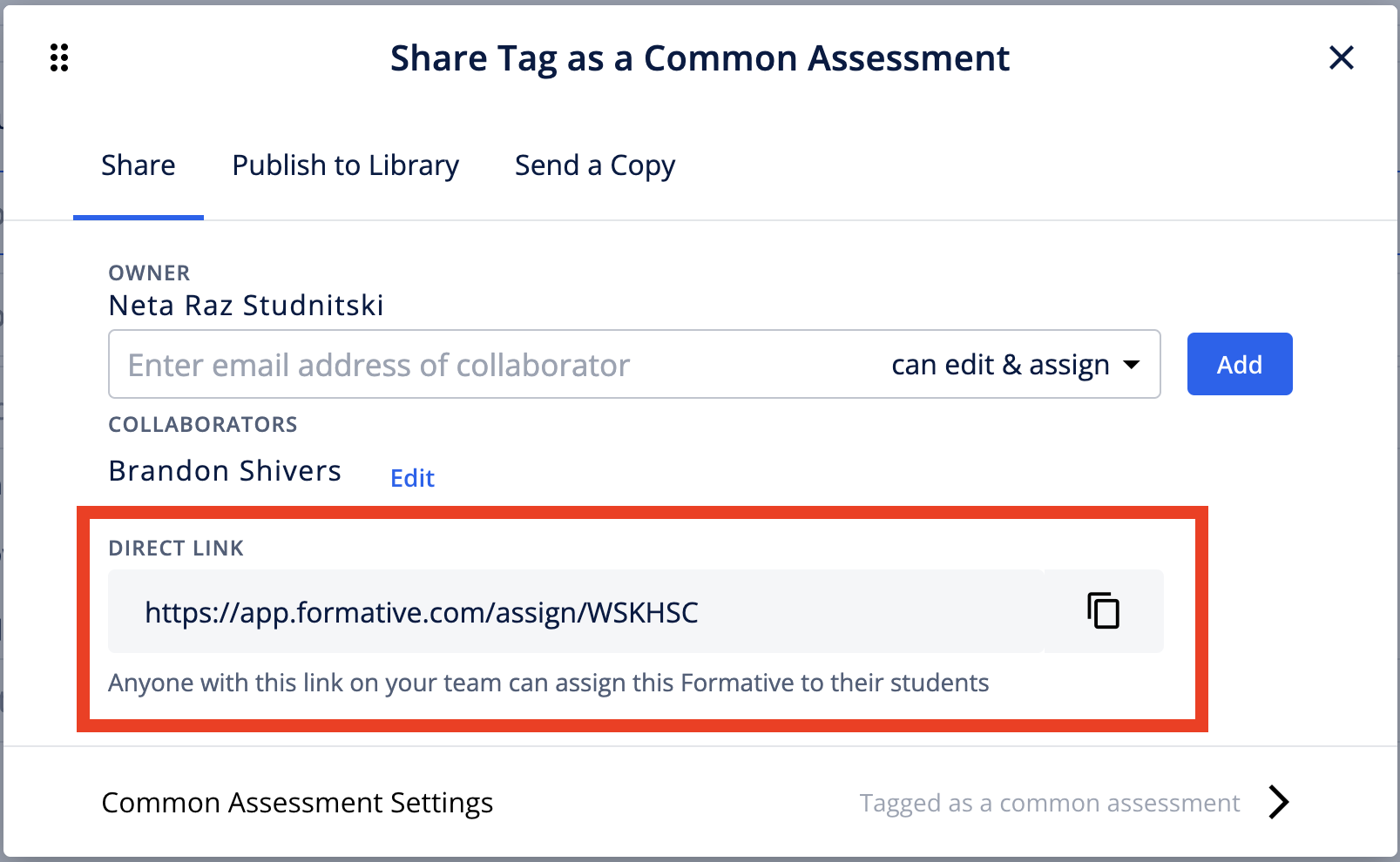
Note: Anyone who grabs a Common Assessment from the private library is grabbing a LIVE copy: if the original author changes or updates the Common Assessment, those changes will reflect immediately on the screens of all users with a copy, including students currently taking the Common Assessment.
Administer common assessments
Share data among plcs, add security via respondus lockdown browser, respondus lockdown browser.
For school network-managed Chromebooks, Windows, Mac, and iPads, this browser is available as an optional add-on to a Partner Subscription to help keep assessments secure. It prevent students from opening any other apps, tabs, or windows. However, even with this browser-locking technology, it may still be possible for students outside the classroom to use other resources to help them with test questions; students might ask a sibling for assistance or use the internet on a second device.
Support LTI 1.3 to integrate within Canvas, Schoology, etc

Integrate with SSO and SIS providers.
What is sso and why is it used.
Single Sign-On (SSO) allows you to use your Google, Microsoft, or Clever profile to authenticate you when logging into Formative. If your school account is tied to one of these providers, we encourage you to use SSO for efficiency.
If you don't use one of those providers, you can create a password for your Formative login. Students and teachers can use either method.
With Formative you can sync rosters with your Student Information System (SIS).
Syncing rosters with your SIS is one way to set up all teacher and student accounts and to automatically place all students and teachers into their classes.
Step 1: Check if you have software that supports OneRoster
In order to set up a OneRoster connection, you will need an SIS or other software system component that allows access to rosters using OneRoster 1.1 API or CSV files. Aeries, ClassLink, PowerSchool Unified , and Infinite Campus are some examples of software that support OneRoster exports using the API integration method.
Some of our customers do not have any system that supports OneRoster. In this case, some have adopted ClassLink, which can be used to add OneRoster support to a variety of SIS systems (read more about that here ). A few others have implemented a custom software solution on their end to generate OneRoster files and then upload them to an SFTP server.
Once you have identified a way to provide us with OneRoster data, you will have to consult its documentation (assuming it is not a custom solution) to determine how to set up a OneRoster export and provide us with the necessary information to access it.
Step 2: Get OneRoster Sync Credentials Or Set up OneRoster SFTP Uploads
For OneRoster API integrations, you are given a OneRoster Base URL, Consumer Key, and Consumer Secret.
Blackbaud users: your base URL is based on your Blackbaud access URL. If your Blackbaud domain name is yourschool.myschoolapp.com, then your Base URL will be https://yourschool.myschoolapp.com/ims/oneroster/v1p1
You can encrypt the consumer secret into a secure sharing URL using https://dead-drop.me . Send the Base URL, Consumer Key, and Consumer Secret to your implementation specialist.
Note: if you are using ClassLink, you can instruct members to share roster data with us instead of sending us the credentials. Check out this article for more details.
If your system does not support OneRoster API integration but exports CSV files that must be added to a ZIP file and uploaded to an SFTP site, please contact us to set up an SFTP account you can use to upload the file.
We only need these files for rostering from zipped CSV files:
- academicSessions.csv
- classes.csv
- enrollments.csv
You can optionally provide courses.csv.
Step 3: Establish scope of the import
In addition to the OneRoster access information, we will want to know which organizations (schools, districts, departments, etc.) you wish to import to help us validate the data we receive; this information also helps avoid importing the wrong users. We will want to know the NCES ID (or other government ID, if available) of each school and district, too, so we can avoid data duplication.
Since your organization will have some degree of control over the users that OneRoster imports, we restrict the imported users to a list of emails and email address domains that we can confirm you control. We will need to know all the email domains that your district owns to enable the import of those users via OneRoster. If you have a subset of users outside your controlled email domain (contractors, for example), we can also accommodate a small number of specific, individual email addresses.
Step 4: Make sure we have the information we need for the import
After doing all of the above, be prepared to provide us with the following information if you haven't already done so:
- If API sync is supported: OneRoster API consumer key, secret, and Base URL (do not send these if data is shared using ClassLink)
- List of organizations to roster
- If applicable, NCES / government identifiers for each organization
- Email domains of the users to import
- When to start the import (if not immediately)
Additional Notes
- Existing Classes: Classes imported from OneRoster do not link or merge with existing classes, so you will have to decide what to do with duplicate classes for teachers who have already set up their classes. It is easiest for teachers to keep existing classes and archive the OneRoster-created classes when they get duplicates. The downside of this process: those classes will not automatically update from the SIS, but existing assignments to the class will not have to be copied to the new class.
- Teacher Login: Teachers will receive emails with some information about their new account, including how to set their password if they need instructions. If they use SSO logins (Google, Clever, Canvas, Microsoft, LTI, etc.), they won't need to create a password.
- Student Login: If students cannot use a SSO login, teachers can set their passwords via the classes page. Students with access to their email can also use the "forgot password" feature to set their password. We also offer the option of setting each student's password to their "identifier" (e.g. Student ID) by default, although doing so is not the most secure approach.
- Administrator Users: Although we normally only set up students and teachers using OneRoster, we can use it to control Formative administrators. If you provide us with a list of the members you believe should be formative administrators, we can check whether that information matches OneRoster user data and then update OneRoster in addition to students and teachers. If this information does not match, then Formative administrator access will have to be managed manually.
- Class Start & End Dates: If OneRoster data includes start and end dates for classes, then classes will not be created if they are more than fourteen days away. Classes created in the past that are more than fourteen days old will be marked as archived.
The following platforms provide a OneRoster API that is known to work with Formative:
- Focus School Software
- Infinite Campus
Integrate with SSO and SIS providers
Add to a great standards-aligned item bank, see results by demographics, sped, ell, and more, report student growth across any team, school or district, trusted by schools and districts around the world.

Here's what our instructional leaders have to say
District supervisors and directors can access the data to allow for collaboration and reflection with administrators and specialists. Once published, all are updatable at any time, and any changes will update scores and tracking for students.
Superintendent
Formative assessment is the true pulse of rich instruction. This phenomenal platform allows us to provide instant feedback to students while simultaneously adapting to an ever-changing virtual landscape.
School Principal
It is probably one of the very best programs I have ever come across in education, and I’ve been here for 31 years...The customer support is outstanding!
Curriculum Specialist
Fingers crossed that SCEC admin will buy into the full subscription. What would life be without Formative in the classroom? Thank you for creating such an app. It is a teacher's online dream for assessments!
See why Technology Coaches from Summit Public Schools love Formative!

IMAGES
VIDEO
COMMENTS
ಸಾಧನಪರೀಕ್ಷೆ-1 | ಪ್ರಥಮ ಭಾಷೆ ಕನ್ನಡ | 9 ನೇ ತರಗತಿ | Formative Assessment Test-1 | FA-1 | First Language ...
To Help the students prepare for the 1st Language Kannada Exam to be conducted for 125 Marks (Formative Assessment - 25 Marks, Summative Assessment - 100 Marks), Last Minute reference Study Materials (Model Papers, Previous Papers, State Level Preparatory Exam Papers, Passing Packages, Practice Sheets, Scoring Packages, Notes, Practice Papers, Radio Programmes - Parkisha Siddate) are ...
June 13, 2023. As per the Pattern of SSLC Examination released by the Karnataka School Examination and Assessment Board (KSEAB) 4 Formative Assessment (FA) to be conducted for 125 Marks (1st Language 25 Makrs and Other Subjects 20 Marks), Each Formative Assessment 1 to 4 to be conducted for 50 Marks (2 FA Activities of 15 Marks each and ...
Karnataka 6th Class FA1 Model Paper. 6th Class EVS (Kannada Medium) FA-1 Model Paper. Click Here. 6th Class English FA-1 Notes. Click Here. Kannada Paper 1 Download. Kannada Paper 2 Download. Kannada Paper 3 Download. English Paper 1 Download.
3. Dipsticks: So-called alternative formative assessments are meant to be as easy and quick as checking the oil in your car, so they're sometimes referred to as dipsticks. These can be things like asking students to: write a letter explaining a key idea to a friend, draw a sketch to visually represent new knowledge, or.
Subjective Test of Class 6th, Kannada Formative Assessment 4 - Study Material. Subjective Test of Class 6th, Kannada Formative Assessment 4 - Study Material. Dashboard Feedback. Logout. Test Details Report. Formative Assessment 4. Starts. Jan 27, 8:30 AM. Duration. 110 minutes. Deadline. Jan 27, 10:20 AM. Maximum marks.
Subjective Test of Class 9th, Kannada Fotmative Assessment 4 - Study Material. Subjective Test of Class 9th, Kannada Fotmative Assessment 4 - Study Material. Dashboard Login Login Feedback. Logout. Test Details Report. Fotmative Assessment 4. Starts. Jan 27, 8:30 AM. Duration. 110 minutes. Deadline. Jan 27, 10:20 AM ...
July 24, 2023. Karnataka State Nali Kali (Class 1 to 3) Formative Assessment (FA) 1 Model Assessment Papers of all Subjects (First Language Kannada, Second Language English, Mathematics, Health and Environment / Environmental Studies) prepared by Subject Experts been provided for reference to teachers teaching Nali Kali (Class 1 to 3) The ...
Subjective Test of Class 7th, Kannada Formative Assessment 4 - Study Material. Digitize your School in minutes with Teachmint's Integrated Platform Book a Demo. Dashboard Login Login Feedback. Logout. Test Details Report. Formative Assessment 4. Starts. Jan 27, 8:30 AM. Duration. 110 minutes. Deadline. Jan 27, 10:20 AM ...
The goal of summative assessment is to evaluate student learning at the end of an instructional unit by comparing it against some standard or benchmark. Summative assessments are often high stakes, which means that they have a high point value. Examples of summative assessments include: a midterm exam. a final project. a paper. a senior recital.
Timing of the administration of 'formative' assessment relative to major assignments in the course is important. Another example of 'formative' assessment is having students write a business letter to King Louis XVI from the perspective of a member of the Third Estate in France prior to the Revolution.
Dakshina Kannada District, Karnataka. ... Examination, Formative and Summative Evaluation, Continuous and Comprehensive Assessment and Grading Block-2: Assessment Procedure Unit-1: Assessment tools and tasks: Assessment of Projects; Performance Based Assessment, Assessment of Assignments; Different kinds of tests and their Construction ...
Classroom-Based Examples. The following examples can be valuable to employ in a classroom setting: 1. Quizzes and polls. Simple and easy to execute, quizzes and polls are a low-effort way of gauging student understanding at regular intervals throughout a lesson. 2. Peer feedback and self-assessment.
What makes something a formative assessment? ASCD characterized formative assessment as "a way for teachers and students to gather evidence of learning, engage students in assessment, and use data to improve teaching and learning." Their definition continues, "when you use an assessment instrument— a test, a quiz, an essay, or any other kind of classroom activity—analytically and ...
formative adjective. forming or capable of forming or molding or fashioning. Synonyms. plastic, shaping. Examples. "a formative experience". "a formative influence". "the plastic forces of nature". capable of forming new cells and tissues.
Subjective Test of 9th STD, FORMATIVE ASSESSMENT-4 Second Language Kannada - Study Material
KSEEB Model Paper 2024 Class 1KSEEB Model Paper 2024 Class 1 SCERT Karnataka Question Paper 2024 Class 1. New Exam Scheme or Question Pattern for Sammittive Assignment Exams (SA1 & SA2): Very Long Answer (VLA), Long Answer (LA), Small Answer (SA), Very Small Answer (VSA), Single Answer, Multiple Choice and etc. New Exam Scheme or Question Pattern for Formative Assignment Exams (FA1, FA2, FA3 ...
1. While in the Formative you'd like to assign, click on "Assign" and choose "Student-Paced" from the drop-down menu. . 2. Select a class (es) to assign the formative to, or create a new one. 3. Click on "Additional settings" to edit after submission settings, return scores or return correct answers to students.
ಶುಲ್ಕವಿಲ್ಲದೇ ಒದಗಿಸಲಾಗುವ Google ನ ಸೇವೆಯು English ಮತ್ತು 100 ಕ್ಕೂ ಹೆಚ್ಚಿನ ...
Click on the triple dot menu within the right-side panel. Choose "Clear Response" from the dropdown menu. Remove all responses for a student: From your main responses tab, click on the student to expand their full submission in the right side panel. Click on the triple dot menu within the right side panel.
ಇದರಲ್ಲಿ 50+ ಕನ್ನಡ ಪ್ರಬಂಧಗಳು ಇದರಲ್ಲಿವೆ, Kannada Prabandhagalu, Kannada prabandha, Prabandha in Kannada, ಪ್ರಬಂಧ ವಿಷಯಗಳು Kannada Prabandha List
assessment. ⇄. assessment, noun. 1. the act of assessing. Ex. (Figurative.) Every assessment of loyalty involves a subjective element (Bulletin of Atomic Scientists). 2. the amount of tax which is decided to be payable. 3. an official valuation. english.
Formative assessment is the true pulse of rich instruction. This phenomenal platform allows us to provide instant feedback to students while simultaneously adapting to an ever-changing virtual landscape. School Principal. St. Helena Arts and Tech Academy in LA. Bernard M.